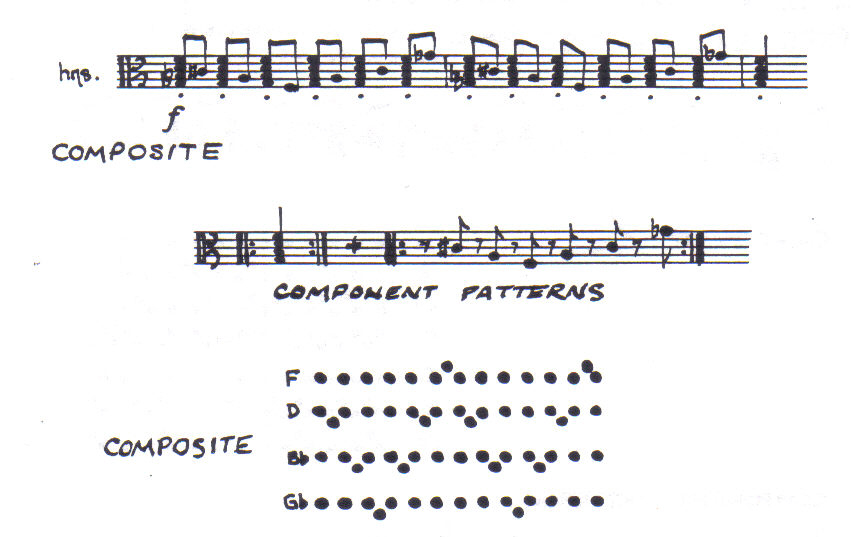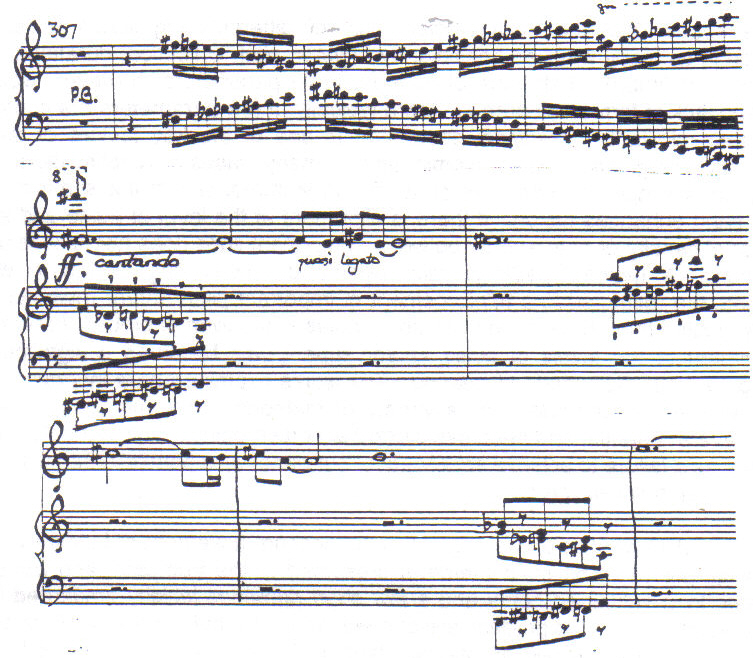Time and Texture in Lutoslawski's Concerto for Orchestra and Ligeti's Chamber Concerto1
Rosemary Mountain
Introduction
Periodicity is an extremely potent device with different
effects and effectiveness at various levels.
The musical material which establishes regularity encourages focus on other elements, while simultaneously contributing
a specific character to the music. Many musical figures involve some
periodicity at a pulse or sub-pulse level, and often these exist within a hierarchical structure. As periodicities
under three or four seconds are grasped directly, their incorporation
into musical configurations helps recognition of future recurrences of those configurations. By maintaining a contrast
in the periods of different coexisting layers of material, the composer can clarify the definition of each layer, thus
making the interplay of the various layers more audible. A basic and
traditional structural function of periodicity is the establishing of a pulse framework. Traditionally, this framework
was manifest as a metric hierarchy.
In additive forms, increasingly common in contemporary works, a single pulse
layer may be the only unifying force. In either type, the regularity is likely
to provide a background grid for more irregular and expressive rhythms.
In the case of metric-style hierarchical frameworks, the irregularities are
frequently at the foreground level, resulting from a variety of subdivisions of
the pulse or "super-pulse" (the term employed here for bar-length periods). In a additive framework, however,
irregularities are typically at higher grouping levels, as a result of
addition or multiplication of a pulse or sub-pulse. The number of layers exhibiting periodicity and the specific relation
of the periods involved have a profound effect on our perception of the music's character. Contrasts are not restricted
to a simple alternation between consonance and dissonance. They can
incorporate different types and degrees of
dissonance, and different speeds and methods for moving from one arrangement to
the other.
A study of periodic elements in music requires an appreciation of what constitutes regularity in time, and how we measure that regularity. Such temporal issues have been faced by many theorists while searching for viable approaches to rhythmic analysis. Although the subject of time provides a fascinating theme for reflection, it eludes the sort of clear definition with which we like to describe our world. The effect on musictheory has been a proliferation of different perspectives, ranging from the stimulating to the confusing.2 The most problematic aspect of such investigations for music is that the experience of duration appears to fluctuate, depending on the individual and on what is being experienced.
The present study examines factors potentially relevant to questions of perceived duration. Those factors include the manifestation of periodicities, and changes in rates and densities of periodic activity. Therefore, the results may be able to contribute to further investigation of our sense of experienced duration in music. Ornstein proposed that experienced duration relates to the amount of information or density of events contained within the duration.3 More recently, it has been proposed that the amount of mental processing involved affects the sense of duration.4 Stockhausen, Clarke, and Tenney have stressed the importance of change in various musical parameters as constituting significant information.5 There is evidence of internal body clocks, controlling the cardio-vascular and nervous systems. However, their relevance for music appears to be in aiding the reproduction of rhythms, and therefore applies to the performer more than the listener.6 A more accessible clock metaphor has been suggested by Benjamin, who points out that certain levels of periodicity such as pulse and meter can function as a built-in clock for the music.7
There is increasing evidence that our reaction to certain rates of periodicity in music is fundamentally linked to motor activity and other physiological processes. All humans possess certain inner mechanisms which operate at very similar levels to those of other humans. Examples include breathing rates, heartbeats, muscle contractions and neuron activity.8 The link between body mechanisms and our perception of musical rhythms appears to be based almost entirely within a small range of periods. We seem most confident in identifying rhythmic configurations which do not exceed the short period of time referred to as the perceptual present (generally estimated as no longer than ten. seconds9 There is a lower boundary as well: our discrimination weakens considerably for durations under about one tenth of a second. The relative length of durations within this band of 0.10" to 10" can be sensed directly. They are probably imprinted as temporal patterns directly to memory, whereas our perception of longer durations is almost entirely dependent on our mental organization of the short components.10 The processing required to apprehend longer durations depends on the experience, education, mood, and mental strategies of the individual. It is doubtless at this stage that the variety of experienced durations originates.
For the purposes of this study, I
conceive of time as referring directly to the rate at which
change occurs. Since change occurs at different rates in different phenomena, the
perception of time depends on the specific phenomenon being observed. A change
of focus is
probably a major factor contributing to the sense of fluctuation in our
experience of duration. Such a change is as
likely to involve a shift in a temporal or parametric focus as in a focus of scene.
11 Ordinarily, we have
multiple references available to our consciousness as we are surrounded by many phenomena, each
changing at its own rate. Everything in our environment evolves or exists at a rate or tempo according to its own
nature; each has its own internal rate of growth and decay. Through
interaction with the environment, we learn![]() affects
the perception of time in music. One of its more obvious results is to slow
down the passage of events, sometimes to the point of near
immobility; and even when volleys of rapid projections of sound
tend to increase the speed of the passage of events, the perceptual sense of
the motion remains
essentially non-dynamic." "The Structure of Time," p.145. To distinguish different phenomena
from each other according to their rate of change. This strategy leads us to apprehend (and to
some extent, predict) the behavior of various things. The more periodic and the
slower-evolving things are the easiest to apprehend.12
affects
the perception of time in music. One of its more obvious results is to slow
down the passage of events, sometimes to the point of near
immobility; and even when volleys of rapid projections of sound
tend to increase the speed of the passage of events, the perceptual sense of
the motion remains
essentially non-dynamic." "The Structure of Time," p.145. To distinguish different phenomena
from each other according to their rate of change. This strategy leads us to apprehend (and to
some extent, predict) the behavior of various things. The more periodic and the
slower-evolving things are the easiest to apprehend.12
Though most phenomena do not exhibit a
strict periodicity, many possess a usual range of movement. Ocean
waves arrive at the shore at a slower or faster speed depending on constants such as land
formation, and variables such as weather and tides. However, they always arrive
at the shore within certain limits: they are never as slow as one every ten minutes or as fast as one every second.
A walking pace is similarly variable but occurs within limits dictated by the configuration of the hip, length of
leg, muscle tone, coordination, etc. The startling and often comical
effect of watching time-lapse photography clearly
illustrates our knowledge of these limits by showing events which change at excessively fast rates. Familiar phenomena thus
become measures by which one can judge the movement or degree of change
in other things. Therefore our perception of things involves a sense of relative temporalities. In addition, most of us have
at some time or another measured our
familiar experiences by clock time. The neutrality of the clock thus provides an indication of the relative rate of
change of disparate events. In music, however, we usually ignore references outside the performance itself. In
electronic music, even the physical actions of performance are often no
longer available as references.
We recognize a table as being a stable
object in our vision because each time the room is
scanned, the table image remains unchanged. Minsky has presented a very plausible explanation of
one aspect of our musical perception by drawing a parallel with this visual strategy. He suggests that certain levels
of periodicity in music can create the feeling of the persistence of a
musical "object". The figure being repeated corresponds to an image, and the sameness of that figure at each pass
confirms its stability.13 This analogy is easiest to confirm with ostinato figures, but seems
applicable to many instances of repetitions in music. For example, a phrase is often followed by another which starts
off in the same way but ends differently. The listener can quickly
compare the differences by mentally placing the profile of the second phrase on
top of the first.
Music by composers such as Varèse often provoke discussion of
"spatial" images in music.14 Structures such as
ostinati (which rely on periodic components) create the impression of
"objects" which remain static in time. Such a compositional aim is
quite
Epstein's suggestion that "music
structures
time15 seems compatible with
the concept of time
described above. By granting each musical composition an identity comparable to
other more tangible events, the listener can perceive time as demonstrated through its particular rate of change. The extreme
flexibility and unpredictability of change in music explains the great diversity in temporal durations experienced
while listening. In some modern
polyphonic compositions (including those studied below) the listener can perceive
the coexistence of two or more musical "forms" which develop at
independent rates and portray independent characteristics. This aspect is the
fundamental difference between true multi-strata works and a more stylized
polyphony which was common within traditional pieces.
In the latter, the interwoven lines are generally understood as being parts of
the same material. The impact of many twentieth-century works is due to
their unabashed presentations of disparate
events; in some cases the works are designed specifically to depict
multi-faceted environments.16
Returning to the question of experienced duration, it may be seen that
differing perceptions of duration result from a
combination of factors. The rate at which time unfolds within the phenomenon
being perceived is affected by the manner and degree in which the perceiver is
following, anticipating, or participating in that unfolding. In addition, the
specific rate at which the phenomenon is
unfolding will be perceived relative to the reference rates of the perceiver. In day-to-day life, an
individual is usually aware of more than one phenomenon at a time. The
profound effect of music on an individual's sense of experienced duration may
well be due to the tendency for a listener to ignore outside references and
give full concentration to that one experience. Because there are no physical
objects involved to suggest familiar rates of motion by size, weight, character,
etc., the range of motion is much less predictable in music than in most other
types of phenomena. In fact, the non-physicality of music makes it an ideal
place to represent or evoke the temporal aspects of any and all kinds of
phenomena, whether human emotions, pastoral images, chaos, or the growth and
decay of an imagined organism.
Music is
bewildering to analyze in terms of time precisely because temporal characteristics are presented in the absence of a
tangible phenomenon. With almost everything else, time can be understood
as the way in which
that particular phenomenon
For many of us, part of music's appeal is that we can forget the relentless pace of time defined by our working schedule. The composer presents a more unpredictable pace of events which maintains our interest by its variety. It would be a daunting task to define, or even describe to universal satisfaction, the sensed duration of each musical phrase in a work. However, the current study may permit the interested reader to understand some of the factors which differentiate one five-minute segment from another.
Periodicity in Texture and Textural Strands
Periodicity in music occurs on various temporal levels, from that of the sub-pulse to large-scale formal structure. At certain rates, regular recurrence of elements is one of the most immediately discernible properties of a work. It can influence our sense of grouping and contribute to our discrimination of formal structure. Research in the cognitive sciences has demonstrated the existence of perceptual tendencies which operate in our discrimination of grouping and segregation in musical contexts. It has also established the existence of perceptual boundaries which affect our interpretation of musical phenomena. Relevant perceptual influences fall into the main areas of memory processing, Gestalt psychology, auditory streaming and fusion, perception of polyrhythms, and associative links and limiting perceptual thresholds which affect our reaction to specific rates of periodicities. One relevant threshold determines our ability to discriminate between similar periods, while others help define the regions of pulse and ornamentation.
Investigation shows that our perception of periodicity alters significantly with fairly minor changes in rate - for this reason, I have found it useful to group musical periodicities into 4 ranges: ornamental/textural, pulse, super-pulse and large-scale. The level of pulse is the most directly associated with motor movement and usually lies in the range of 0.5" - 1.5" (or in musical terms, in the range q = 40, toq = 120). Super-pulse is the pulse-grouping level, corresponding to that of traditional meter, and usually lies in the range of 1.5" to 4.5". Perception of regularity at this level begins to be affected by the musical contents. At the large-scale level (periods longer than 4.5") limits of the short-term memory (estimated around 10") impose a significant restriction and mental organization is fundamental. Therefore the perception of longer periodicities depends not only on the musical context but also on its codification by the listener - the experience, education, mood and mental strategies of the individual are therefore crucial, and the sense of duration can vary greatly.
Rhythms faster than the pulse range (below 0.5") can be grouped in a textural/ornamental category, where they function more in the sense of creating textural or timbral variety. Trills and tremolos are familiar examples of the faster end of this scale. With durations below ca. 0.05", our ability to distinguish the specific order of a set of pitches is almost nil, and therefore it becomes misleading to speak of rhythm per se 17 .
It is increasingly
evident from psychological investigation that periodicity on the ornamentation level is of a slightly different kind
from the level of pulse, and substantially different from that of longer durations. With a predilection for
exploring boundaries of perception,
20th-century composers have experimented with using these very fast periodicities in new ways. Examples can be found in
the works analyzed below. The theme of
Lutoslawski's Cappriccio,
for example, has a
curious quality arising from a boundary-crossing. It sounds slightly like a tape played at
the wrong speed, due to the fast tempo and the high register employed. It moves at a rate
typically reserved for ornamentation and texture, but cannot be heard as either because it
has the pitch and rhythmic contour of a melody. The effect focuses attention, as the
listener must concentrate in order to decipher the information. Ligeti also enjoys playing with
the boundaries of perception, as he reveals while
discussing his work Continuum:
I ... remembered that a harpsichord was most typically an instrument
with a non-continuous
sound .... I thought to myself, what about composing a piece
of music that would be a paradoxically
continuous sound ... that would consist of innumerable thin slices of salami? A
harpsichord has an easy touch; it can
be played very fast, almost fast enough to reach the level of continuum, but not quite (it takes about
eighteen separate sounds per second to reach the threshold where you can no longer make out individual notes and the
limit set by the mechanism of the harpsichord is about fifteen to
sixteen notes a second) .... The entire process
is a series of sound impulses in rapid succession which create the impression
of continuous sound.18
The fast rates of ornamentation are also found in the context of
textures. The effect produced is that of a
layer of sound with a characteristic pitch and density, but containing surface fluctuation provided by quick
movement between elements. Periodicities are, sometimes involved in one or more component strands, and often such
periodicities create rhythmic
dissonance on the foreground level. Even when strict periodicities are not present, the range of durations may be sufficiently
restricted that they can be usefully presented
by an average rate of recurrence. In other words, periodicities can serve as a model
for textural construction.
The
composition of textural passages was championed by composers such as Xenakis, Stockhausen, and Ligeti as they searched
for new ways of organizing sonic material. Stockhausen promoted the term
"statistical field" to refer to the situation where characteristics such as timbre, duration, and
register remained similar throughout a passage.19 The term
accompanied a new compositional approach whereby the composer![]() would select
the precise way in which specific properties would be distributed among various
instruments.20 The textural approach was a very appropriate one for many
twentieth-century composers who wished to
move beyond traditional uses of harmony and meter while retaining a
degree of large-scale control. It permitted the composer to establish
"global" properties for each texture and then to construct formal
designs that would produce varying types and
degrees of contrast. Contrasts in timbre, dynamic level, durations, register,
etc. could be extended to higher levels. For example, a passage
incorporating high contrasts in several
parameters could be juxtaposed with one of low contrast. For composers such as Ligeti
and Stockhausen, such an approach to composition proved conducive to
fascinating designs.
would select
the precise way in which specific properties would be distributed among various
instruments.20 The textural approach was a very appropriate one for many
twentieth-century composers who wished to
move beyond traditional uses of harmony and meter while retaining a
degree of large-scale control. It permitted the composer to establish
"global" properties for each texture and then to construct formal
designs that would produce varying types and
degrees of contrast. Contrasts in timbre, dynamic level, durations, register,
etc. could be extended to higher levels. For example, a passage
incorporating high contrasts in several
parameters could be juxtaposed with one of low contrast. For composers such as Ligeti
and Stockhausen, such an approach to composition proved conducive to
fascinating designs.
Ligeti's ideas were influenced by his
realization that attempts to serialize
durations
could result in an undifferentiated rhythmic shape.21
When a series of durations
are distributed with equal frequency
over a given period of time, the resulting textures
composed of the same mix of
durations can produce a bland durational profile. Because we employ a mode of
listening that extends beyond adjacent pairs of notes, the effect of the
contrast between two durations can be dulled by a lack of contrast between
adjacent groups
of
durations. Choosing to listen to a passage texturally often requires a further
broadening of
the temporal focus. In such a case, the listener receives data from a longer
time period before codifying it. Since non-codified data is retained only in
the short-term memory buffer, that time
period is restricted by the limit of the perceptual present. However, the
composer can help the listener extend the time period by minimizing the
rate of information presented by the music.
Ligeti was
particularly interested in the perceptual boundary of ca. 0.05", below
which the ear cannot
perceive distinct order of pitches.22 He followed Koenig's example by
Since you cannot play an instrument
fast enough to produce a succession of notes at a rate
of twenty per second, I built the rhythmic shifts
into the music. For instance, twenty-four violins would play the same tune but with a slight
time-lag between them. The figurations were almost
identical
but not quite.24
In a textural
passage, a particular state of densities and proportions is often maintained for a sufficiently long period of time
that perceived changes can be understood as a modification of the basic
state. Works such as Atmospheres were influential in their presentation in textural passages of unprecedented
length. The minimal movement exemplified
by the music of Steve Reich also had considerable influence in training
listeners to listen "texturally".
Certain other cultures, such as that of Indonesia, have long traditions of music which we would consider textural. Some
early examples of texture in twentieth-century
Western compositions were directly influenced by such music.25
Because of the prominence of extended
textural passages, the modern concept of texture often conveys the notion that there is similarity in
several parameters for a relatively long time-span. However, such similarity is not a prerequisite. Any complex
sound will convey a sense of texture
when the ear has difficulty in segregating the component parts. Lutoslawski's
third movement contains a passage where the "textures" are separated
by rests and last for a few seconds only, producing a foreground rhythm by
their pattern of occurrence.26 Despite the brevity of these bursts
of sound, the similarity of their
construction to
other more clearly textural passages earns them the description of texture. The
similarity between the various fragments gives a clear impression of the
existence of a longer textural fabric from which short pieces have been cut and
pasted.
Ligeti is one of the masters of
maintaining and manipulating textures over extremely long periods of time, up
to several minutes' duration. Striking examples of lengthy textures are found
in works which precede his
Chamber Concerto, but the latter work is particularly appropriate for the present study
because of the design of its third movement. That movement presents
several textures each constructed by the same means: multiple periodicities overlaid in close and complex
relations to each other. Although the movement is by no means static, it contains no discernable melodies (with the
exception of a few sustained notes
near the beginning). Instead, each voice functions as a component of one of the various textures. Attention is sustained by
the interplay of the periodicities of the component layers, by
pitch/registral movement throughout a specific texture, and, on a larger scale, by contrast between the various textures
involved. Textural passages of simpler construction
will be examined first. Those of Lutoslawski's works are frequently presented in the more traditional function of a backdrop to
melodic material. These can be divided into two distinct types of textures,
each creating a different perceptual effect. One type operates in rhythmic
unison and produces the effect of texture through as continuous differentiation
in pitch and timbre. The other type
creates foreground dissonance through an overlay of different pulse subdivisions, or by more additive
means such as the continuous repetition of a very short figure.
A set of textures which exhibit rhythmic consonance, and often rhythmic unison, occurs in the third movement of Lutoslawski's Concerto for Orchestra. The textures provide a complex background for a familiar theme moving primarily in long notes.27 They are of two types: sparse short segments of quarter-notes played by lower strings (pizzicato) and brass (except horns, see Example 1), and denser, longer segments played alternately by horns and woodwinds (see Example 2).. The denser textures exhibit an interesting construction, as each instrument plays only two pitches yet the composite effect produces two layers: one of repeated static chords and the other of a chordal line moving up and down.
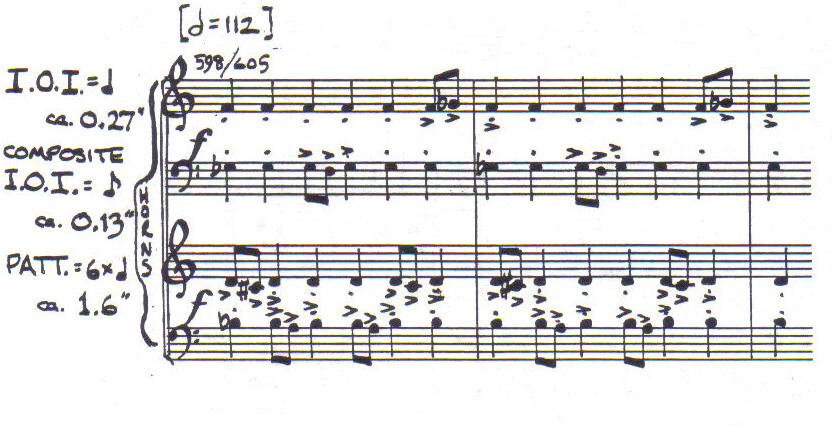
Example 1: Lutoslawski, Concerto for Orchestra, III, 598 - 599 / 605-606 28
Reprinted by Permission of Edition Wilhelm Hansen / Chester Music New York, Inc. (ASCAP) All Rights Reserved.
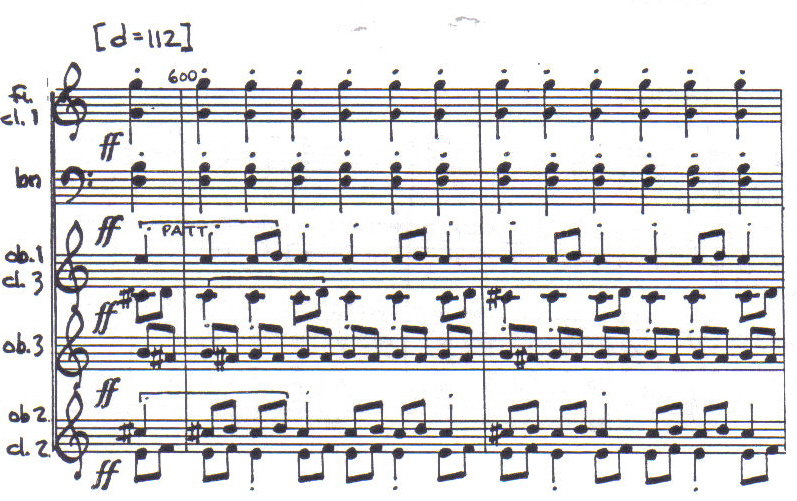


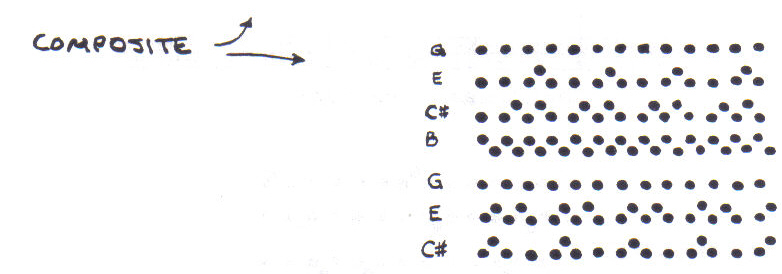

Example 2: Lutoslawski, Concerto for Orchestra, , III, 600-601
Reprinted by Permission of Edition Wilhelm Hagen / Chester Music New York, Inc. (ASCAP) All Rights Reserved.
The same set of textures returns in m.659 at a slightly faster tempo. This time, the melodic line is replaced by a line with similar profile but without the detail of the previous statement, encouraging the listener to focus more attention on the accompanying texture. The passage is much longer (24"), has more inner complexity, and incorporates some internal shifting of patterns. Initially, most instruments participate, but gradually the texture, thins, though the eighth-note pulse is always articulated. The reduction of activity in the texture is compensated for by the transformation of a static pulse in the lower instruments into an ascending chromatic line (Example 3).

Example 3: Lutoslawski, Concerto for Orchestra, Ill, 659-665.
Reprinted by Permission of Edition Wilhelm Hansen / Chester Music New York, Inc. (ASCAP) All Rights Reserved.
A passage of three bars' length in Lutoslawski's work seems textural despite its brevity and relatively long durations, because it exhibits temporal symmetry. This symmetry indicates a closed system rather than a goal-directed passage, and the careful dove-tailing of recognizable harmonic patterns conveys this characteristic to the alert listener. One layer of sustained notes in the horns is the background for three other layers. Together they produce a simple composite rhythm of a quarter-note articulation which aligns with the melodic material. Three groups of instruments play dissonant, internally symmetrical, duration patterns- (Example 4). The pitch patterns of each group form harmonies which, though internally consonant and beginning on a perfect fifth, also exhibit dissonance during the three bars; that relationship helps maintain their independence.


Example 4: Lutoslawski, Concerto for Orchestra, Ill, 593-595
Reprinted by Permission of Edition Wilhelm Hansen / Chester Music New York, Inc. (ASCAP) All Rights Reserved.
Textures constructed through a superpositioning of different subdivisions are considerably denser than those exhibiting rhythmic consonance on the foreground level such as those just described. Three related passages in the first movement of Lutoslawski's work present an interesting opportunity to study both types within a similar framework. In each case, they accompany the slow second theme of the movement. At (5), two layers of texture each move in eighth notes. Although the pivots in the scalar figures of the clarinet coincide with rests in the oboe figure, that relationship is obscured by accents in the oboe line which precede those rests. As the pivot points provide the only plausible accent point in the clarinet line, a "Type B dissonance" results.29 In combination with the relatively uncommon grouping length of five eighths, the (irregular) insertion of some shorter groups, and the difference in character of the contours, considerable irregularity is audible (Example 5).

Example 5: Lutoslawski, Concerto for Orchestra, I, 41-45
Reprinted by Permission of Edition Wilhelm Hansen / Chester Music New York, Inc. (ASCAP) All Rights Reserved.
![]()
![]()

Example 6: Lutoslawski, Concerto for Orchestra, I, 64-66
Reprinted by Permission of Edition Wilhelm Hansen / Chester Music New York, Inc. (ASCAP) All Rights Reserved.

Example 7: Lutoslawski, Concerto for Orchestra, I, 103-108
Reprinted by Permission of Edition Wilhelm Hansen / Chester Music New York, Inc. (ASCAP) All Rights Reserved.
At the next statement of the salve theme, a related but more complex accompanying texture is constructed (Example 6). Dissonance is extended to the foreground level by the simultaneous presentation of different subdivisions of the dotted quarter-note. On the other hand, the coinciding of those subdivisions emphasizes the pulse. The scalar pattern Which appeared at (5) in eighth notes now appears in sixteenth notes. It maintains the same period of time between pivots, and thus covers a much greater distance in register. The other layer played by the oboe at (5) now appears in canon. The two parts of the canon can be clearly heard as distinct layers, because the accents and the difference in pitch/registral level prevent them from fusing. Another figure in the 'celli and bassoons-emphasizes the dotted half duration by sequential pitch patterns. As this line moves mainly by step, it is similar to the clarinet line of the previous statement. Therefore, the changing of the clarinet movement from eighths to sixteenths may have been a crucial move in maintaining segregation. The lyrical theme is easily distinguishable from the various textural layers by its tempo, its lyrical nature, and by its recognizability from the previous statement.
At the third statement (11), the shortest duration in the texture returns to the eighth note, so the only foreground dissonance is a 2:3 ratio of two divisions of the dotted quarter. This time the texture is very full, due to a lack of rests, parallel harmonies in the strings, and a slow sustained line in trombones in addition to the foreground dissonances (Example 7). The distinction between figure and ground tends to reverse in this passage, owing to an increase in activity in the ground and the familiarity of the theme itself. The different layers of the texture are individually modulated by dynamic shaping or harmonic thickening, thereby emphasizing their independence. Subsequently, the various lines are interrupted by an increase of attack density and a decrease in pitch movement. This interruption serves in part as an anacrusis to a major downbeat of the theme.
The chorale section in the third movement of the same work contains more examples of accompaniment texture characterized by foreground dissonance. The first full statement of this texture is at mm.715. Celesta, harps, piano, and percussion all repeat patterns which each provide a different subdivision of the half note in the ratio 3:4:5 (Example 8). The effect is a reinforcement of the half-note period and, with the aid of the percussion rolls, a thickening of the texture. The piano and celesta patterns also articulate the two-bar period through repetition. This grouping provides a subtle continuation of the two-bar period already established and thereby helps maintain the vibrancy of the hemiola effect of the chorale theme. The subdivisions are at quite a fast rate, falling within the textural/ornamental zone. Their function as texture is therefore easily grasped, as the density of note attacks is too high to perceive as rhythm in itself. In the preceding sections where piano and harp each played alone, they performed quintuplets rather than slower rates. The. higher density thus helps establish the textural function from the first entry. •
A fragmented texture occurs as an accent to a variation of the passacaglia theme in the third movement (Example 9). The passage first occurs at m.802, and is later repeated at m.822 with a slight change in the final bars. Texture is produced by the superpositioning of trills, tremolo, and fast-moving triplet figures. What makes this texture unusual is its short durations and its function as ornament on a larger scale. The segments are separated by much sparser writing, so there is a considerable accent resulting from the initiation of each textural fragment. Since the component parts cannot be distinguished, however, the textural fragment is grasped as one single, if prolonged, anacrusis to the following beat. This effect is reinforced by a dramatic crescendo in the horns, and by the periodicity of the texture's recurrence.
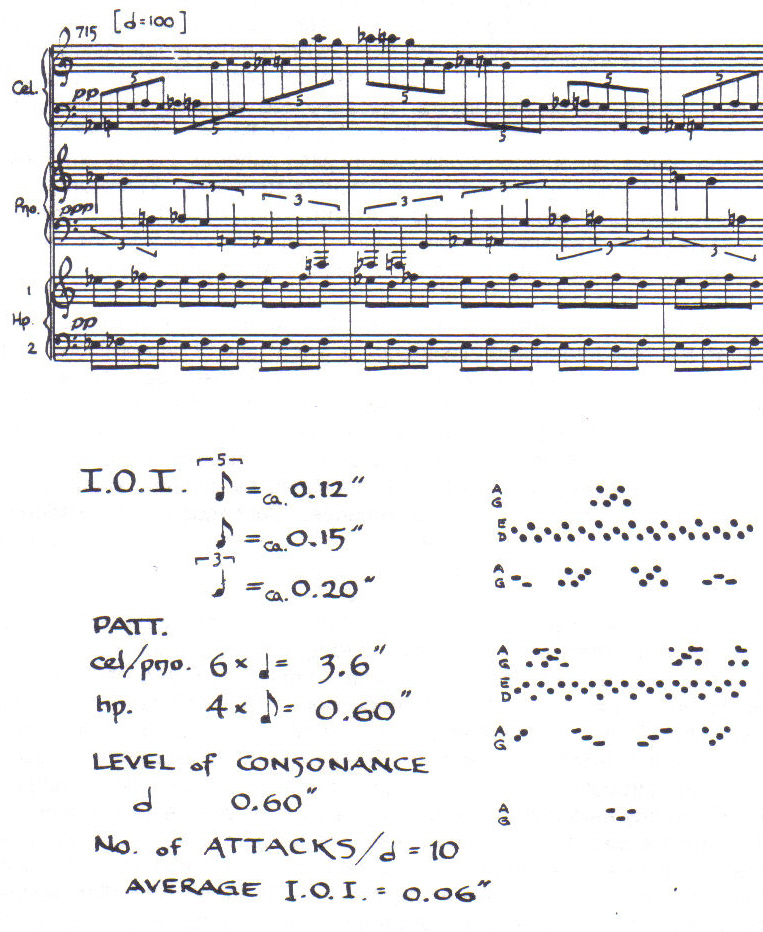
Example 8: Lutoslawski, Concerto for Orchestra, III, 715-717
Reprinted by Permission of Edition Wilhelm Hansen / Chester Music New York, Inc. (ASCAP) All Rights Reserved.
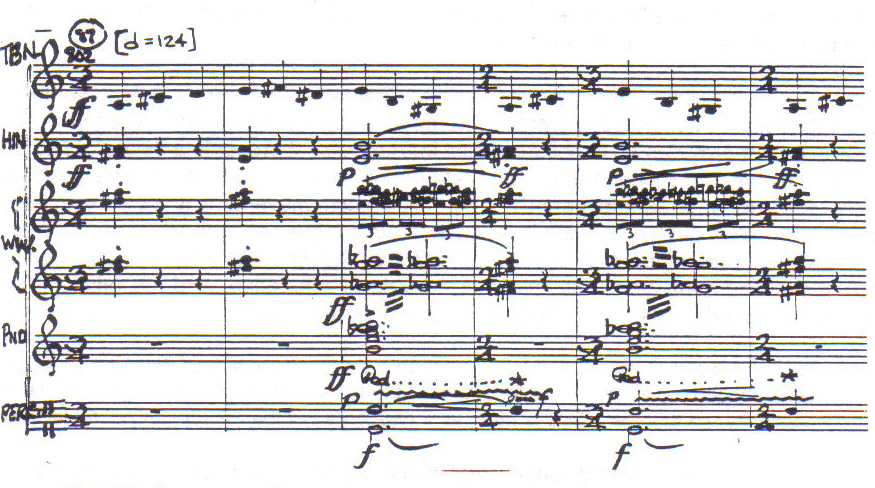
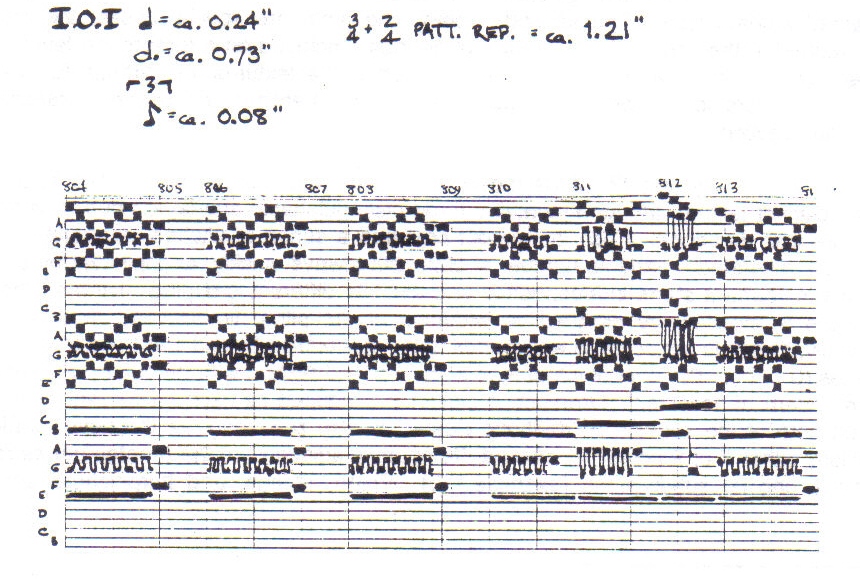
Example 9: Lutoslawski, Concerto for Orchestra, III, 804-813
Reprinted by Permission of Edition Wilhelm Hansen / Chester Music New York, Inc. (ASCAP) All Rights Reserved.
The third movement of Ligeti's Chamber Concerto is full of textural variety. Since the various textures are created through the superpositioning of differing periodicities, the movement provides an excellent model for analysis. It presents a series of textures, with overlaps between a few of them. Each texture involves several instruments each playing a pitch repeated at a certain periodic rate. The pitch movement is very restricted, either remaining on one pitch or moving in a single direction by small intervals or through glissandi. The textures are contrasted by several means: the specific instruments, pitches, pitch movement, and dynamic levels involved; the rate of reiteration; and the relationship of the periods produced. Ligeti describes the resulting textures as:
the type labeled 'like a precision mechanism' ... characterized by a specific rhythmical configuration: a state ... represented in terms, not of a 'smooth', but of a 'fine-ground° continuity, so that the music is seen as if through a number of superimposed lattices.30
The nine distinguishable textures in the movement are listed in example 10 and named alphabetically. The second, eighth, and ninth are special cases; the others are described in the figure with the range of periods employed on a foreground level. Despite the central role of periodicities in the formation of the textures, or perhaps for reasons of balance, there is no apparent periodic relationship between the overall durations of the various sections.
The first 47" of the movement (up to m.12) can be considered as presenting one distinct texture, though it contains three distinguishable sub-layers due to variations in timbre and durations. Each instrument presents a series of pitches (Example 11a); each pitch is reiterated a variable number of times but always quickly, and initiated by an accent. Each instrument starts independently and exhibits different grouping rhythms. The overall texture is modified by progressive widening of the pitch, timbre, and duration choices. Initially, timbre is restricted to woodwinds, pitch to a unison E, and durations to thirty-second notes (0.125"). The overall effect is of a fine-grained texture with irregular punctuation from the pattern of accents.31 Gradually a cluster is produced as each instrument moves to the next note of the series. A "rhythmic cluster" is also produced, as the new durations are initially either 7 or 9 notes per second, "temporally adjacent" to the 8-notes-per-second rate of the original subdivisions (Example 11b). Piano, strings, and harpsichord enter soon afterwards. Though linked to the woodwind layer by pitch and duration, they are differentiated by timbre and by much briefer pauses between groups of notes. Piano and harpsichord maintain the fast reiterations while the strings introduce slightly slower durations. The sharing of the same pitches links the three layers but perceptual fusion is thwarted by the fading out of the woodwinds.

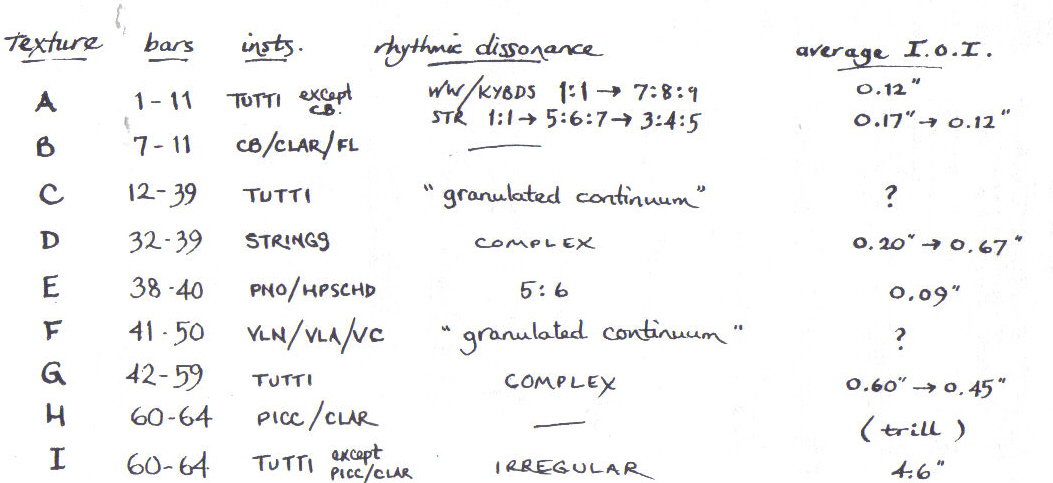
Example 10: Ligeti, Chamber Concerto, III Schematic Representation
Reprinted by Permission of Edition Wilhelm Hansen / Chester Music New York, Inc. (ASCAP) All Rights Reserved.
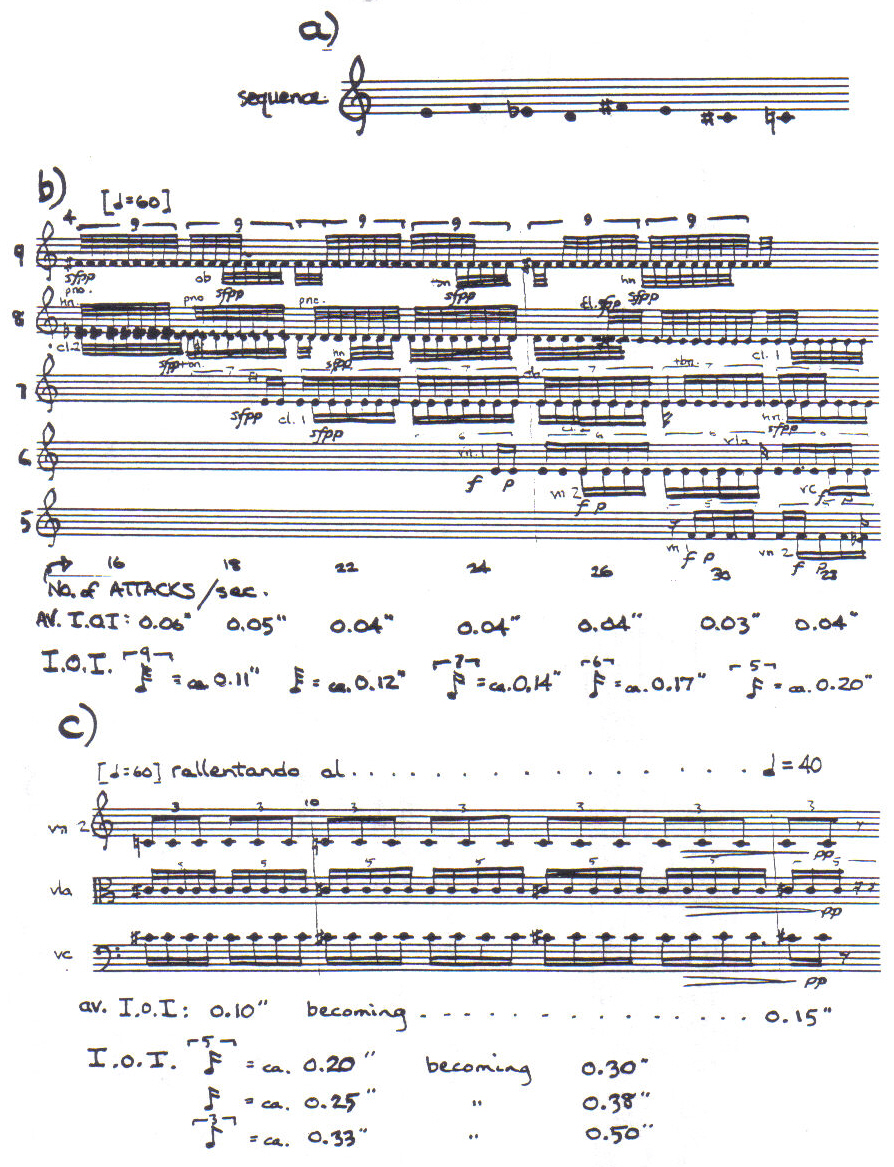
Example 11: Ligeti, Chamber Concerto, III Texture "A" mm. 4-5, 9-11
© B. Schott's Söhne, Mainz, 1974. All Rights Reserved. Used b permission of European American Music Distributors Corporation, sole U.S. and Canadian agent for B. Schott's Söhne, Mainz.
After ca. 6", the double bass creeps in with a sustained D played as a harmonic. The remaining pitches of the series which follow the D are similarly introduced as sustained notes in clarinet and flute. Together they produce a cluster which continues sounding until the end of the passage. Although these notes are obviously contrasted from the rapid reiterations of the rest of the texture, their durations are so long that they considerably exceed the perceptual present. Therefore, within a few seconds they tend to fade into the background, adding color to the texture, rather than movement or contrast. More prominent are the reiterated notes introduced by the strings. Being slightly longer in duration than the previous articulations, they effectively slow the pace. In mm.8-11, the longer durations combine with repetition to enable the listener to hear the 5:4:3 dissonance of the string patterns. The patterns coincide every beat, initially articulating a 1-second period and delineating a tempo change by coinciding ten times throughout a rallentando before dying away.(Example 11c).
Texture C has a structure similar in many respects to the preceding passage, but results in quite a different effect. All instruments (except double bass) start simultaneously, the subdivision durations are shortened, the registral range widened, and the rests omitted. All instruments play slow descending and/or ascending chromatic lines (Example 12). During the passage, the number of instruments changing pitch at any one time gradually increases. The wide registral span is defined immediately by octave displacements of the starting pitch. Each instrument moves to its next note at an independent time, but the change of pitch is not accented as it was in Texture-A. Uniformly soft dynamics, medium durations, and similar articulations increase the tendency for the various parts to fuse. As the precise rate of reiteration is chosen by the individual performer, a subtle dissonance of attacks produces what the composer describes as "a 'granulated' continuum". A striking characteristic of this texture is the incorporation of glissandi. The string glissandi are quite slow, taking up to 3" to move the distance of a semitone. By contrast, the trombone remains on its first pitch for almost one and a half minutes, then takes only 5" for a glissando covering a major sixth. Both are quite audible, but the trombone glissando is more prominent due to its speed.
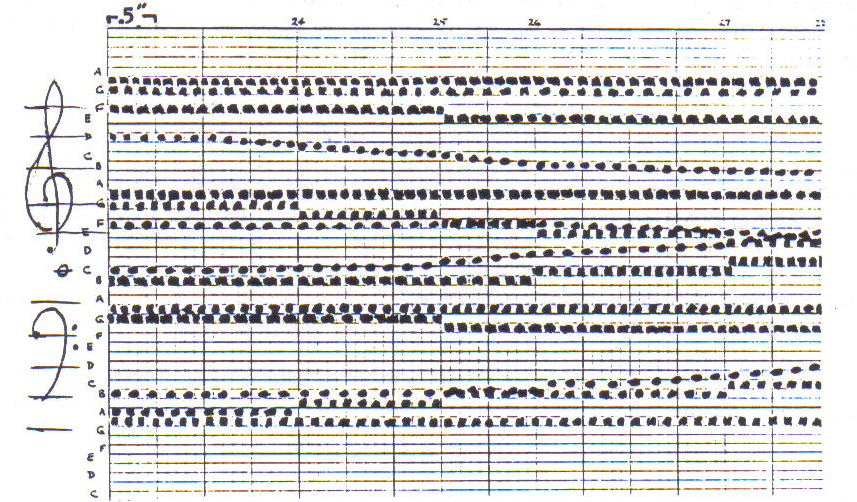
Example 12: Ligeti, Chamber Concerto, Ill Texture "C" 23 - 27.
Texture C continues for almost a full minute, although its last 20" overlaps with Texture D (Example 13a). The new layer is quite distinct, as it is introduced by the double bass fortissimo at the significantly slower rate of 3 per second (0.33"). The other strings abandon their participation in the previous texture and join in, also at fortissimo, exhibiting a variety of articulations including the sharp attack of the "Bartok-pizz.". Each group of notes in this texture is assigned a different but relatively slow rate of recurrence, varying from periods of ca.-0.2" -to-0.67" (example 13b). Ligeti notates the various rhythms in different tempi as well as by different subdivisions. This strategy produces an extremely complex relationship between the instruments, with virtually no coinciding of attacks.
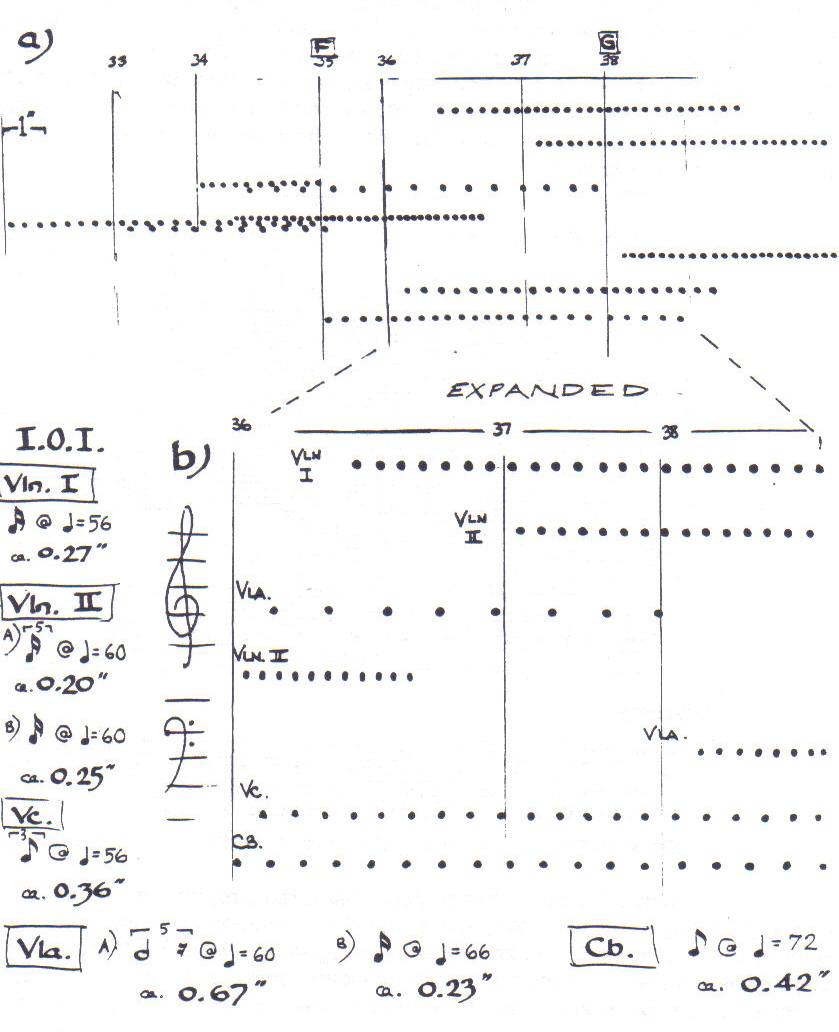
Example 13a and b: Ligeti, Chamber Concerto, Ill Texture "D" 32 - 39
Texture E begins with staccatissimo, molto secco reiterated chords in harpsichord and then piano. The periods of their durations mediate between those of the woodwinds and the strings; their attacks create a 5:6 dissonance coinciding every beat (ca.-0.91"). The similarity of their durations, articulation, and pitch aggregates contribute to their fusion and to their segregation from the other instruments. Texture F represents another instance of a "granulated continuum". It consists of string pizzicato chords played softly but "as rapidly as possible", creating a frenzied effect which cannot (and should not) be dissociated from the actual state of tension in the performer.32 The incorporation of slow glissandi on the middle note of each chord is reminiscent of Texture B.
Texture G begins at m.42 when several instruments present a much slower reiteration of very short notes, all on the same low pitch. A rather comical effect is produced by the contrast of the low register and slow articulation with the preceding frenzied texture in the strings. The sense of texture is challenged by the (relatively) long periods, which tend to make the notes sound as distinct entities rather than as grains in a continuum. It is therefore possible to perceive an irregular rhythmic line resulting from the composite pattern of notes. The durations are outside the textural/ornamental region, so to hear them as fused into one layer involves a considerable stretching of temporal focus. A focus on one specific timbre will enhance the listener's ability to hear the lines as independent and periodic.
After 14", five more voices join in simultaneously. Together with two notes added to the piano part, they produce a cluster in a high register. The new entries present periods slightly faster than those of the lower layer, but slow enough to suggest a connection. This interpretation is reinforced by the piano link, which plays its high notes in the same rhythm as its low ones. The registral gap creates an odd effect, stretching the fusion/fission boundary (Example 14). After a few seconds, some instruments begin to slow down while the others maintain their original pace. The effect is quite startling, creating a slight perceptual dizziness and causing a segregation of layers. The instruments which slow down theoretically do so together, but since they are playing intricate subdivisions at different rates, there is ample opportunity for minor variations which can cause further perceptual blurring.33 In addition, the first rallentando coincides with the final glissandi in the viola and cello as they finish the previous passage.
![]()
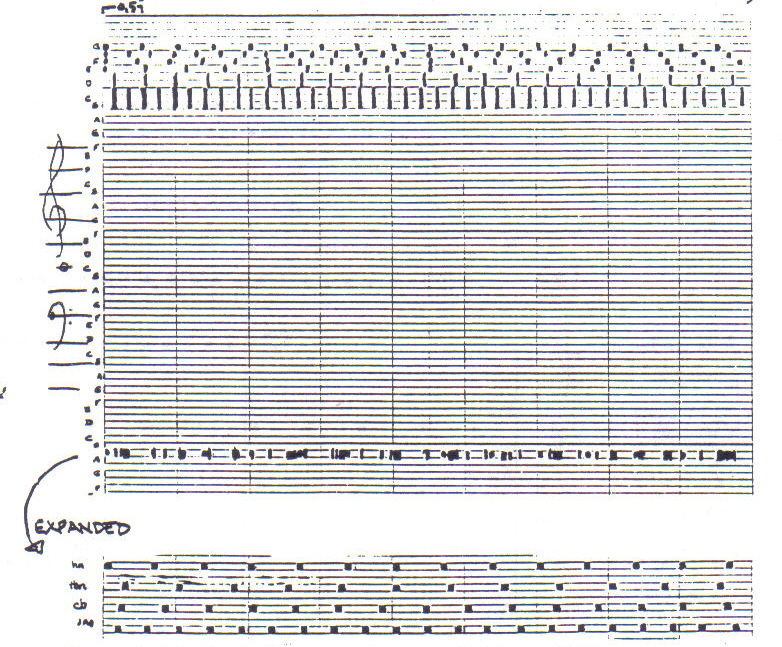
Example 14: Ligeti, Chamber Concerto, Ill Texture "G" mm. 46 -47
At m. 50, violins enter at ff possible (pizzicato) and ca. .13" later, viola and cello similarly; all play notes belonging to the high cluster already sounding. Such a beginning is reminiscent of Texture B, with an exchange of registers. Violins I & II should theoretically be consonant with trombone and horn, as those instruments are at the same tempo, and playing multiples of the same subdivisions. However, there is no insurance that they will start in phase, and in fact as the brass are maintaining their own tempi, it is likely that there will be some discrepancy. Ligeti is naturally aware of this tendency, and instructs:
The players left by the conductor on their own keep as accurately as possible to their individual tempo... however, since they cannot measure the tempo, but only estimate it, tempo fluctuations may occur. Synchronization of the (non-conducted) parts is not to be striven for; in fact, slight shifts in the metre are welcome.34
Again, theoretically only, 'cello and piccolo have the same periodicity. More likely to be perceptible is the relation of attacks in harpsichord and piano:when harpsichord reaches el = 40 they should be in a 1 :1 proportion.35 This alignment should become audible because no matter how inaccurately the parts are aligned, the parts will converge momentarily. Such an approaching unison can easily attract attention.
The last section of the movement consists of trills and sharp attacks which together form a slightly uneven pattern of pulses on the same high pair of pitches (D 6/E flat). There are two possible interpretations. On one hand, the irregularity links this passage to the irregular accents of the first texture of the movement, and thus contributes to a sense of closure. In a different context, this interpretation would likely be the only plausible one. However, the context of the movement suggests that these few notes are delineating another (very sparse) texture produced by overlapping periodicities. The passage may therefore be interpreted as several layers of periodicity moving quite slowly in and out of phase. Despite the fact that the intervals between attacks in the same timbre are not strictly periodic, they are easily interpretable as slowing down. The composite pattern is not regular, but can be sensed as increasing the durations between attacks. In either interpretation, the sparseness of the texture conveys a dispersal of energy appropriate to the end of a movement.
Textural Strands
There are numerous instances in Ligeti's work where two or more lines are easily perceived as forming one distinct layer; these passages share some properties with the types of texture already examined. However, in many cases the resultant textures are confined to a narrow pitch band, and exhibit a collective modulation in shape, note density, dynamics, etc. Therefore they exist in a state somewhere between texture and melody and can be more easily thought of as "textural strands". When such strands coexist, their interplay can produce a resemblance to contrapuntal design. An examination of these strands provides an interesting survey of perceptual effects, especially those involving fusion and fission. Even confining ourselves to a study of those which exhibit some periodicity gives a variety of examples for perusal.
![]()
There are numerous instances in Ligeti's work where two or more lines are easily perceived as forming one distinct layer; these passages share some properties with the types of texture already examined. However, in many cases the resultant textures are confined to a narrow pitch band, and exhibit a collective modulation in shape, note density, dynamics, etc. Therefore they exist in a state somewhere between texture and melody and can be more easily thought of as "textural strands". When such strands coexist, their interplay can produce a resemblance to contrapuntal design. An examination of these strands provides an interesting survey of perceptual effects, especially those involving fusion and fission. Even confining ourselves to a study of those which exhibit some periodicity gives a variety of examples for perusal.
In the middle of m.19 of the first movement, for example, harpsichord and piano enter simultaneously with a pp "cadenza" figure to be played as fast as possible. The motor skills of the performers and the differing actions of the two instrument ensure that they will not be in rhythmic unison. Nevertheless, the simultaneous entries, the similarity of the figures and the sharing of the same pitch range and dynamic level ensure that they can be heard as two twisted strands of the same layer. Subsequent pairs of entries in the strings playing very similar lines form a type of canon (Example 15). Similar passages occur later in the movement such as at m.29 when all strings except double bass play Prestissimo, senza tempo, in a very narrow pitch band. There, all four begin simultaneously and move together to sul ponticello, then ordinario, then sul tasto; the timbral shifts fuse the four together firmly.
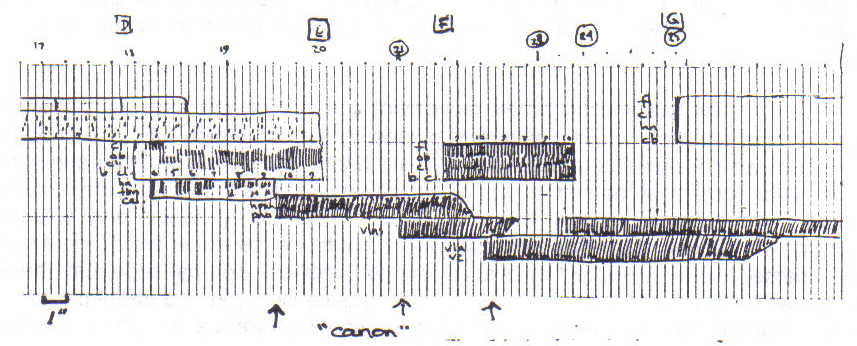
Example 15: Ligeti, Chamber Concerto, I mm. 17-25
© B. Schott's Söhne, Mainz, 1974. All Rights Reserved. Used b permission of European American Music Distributors Corporation, sole U.S. and Canadian agent for B. Schott's Söhne, Mainz.
Forming a contrast to the "canonic entry" in the strings is a textural strand presented by the woodwinds (example 16). Although the woodwinds' layer incorporates dynamics, pitches, and short durations similar to those of the strings, it is readily perceptible as a distinct stratum. One factor which contributes to the sense of fission is a more measured rhythmic notation which removes the franticness of performance associated with the directive "as fast as possible." In addition, a legato articulation contributes to the difference in character. Most noticeably, the woodwinds begin simultaneously and continue in rhythmic unison, presenting a strongly unified texture.36 The rhythmic unison is especially striking as it involves very subtle variations of a general regularity; the number of subdivisions per beat differs by only one from that of the neighboring beats. As the duration of the notes is altered from one beat to the next by less than 0.02", the effect could be considered comparable to microtonal shifts in pitch.
The fact that the three instruments exhibit identical fluctuation links them even more firmly than if they were playing a more rigid periodicity. It implies a common modulator, and is thus similar to the effect of the timbral shifts in the string passage described above.
The effect of
slight rhythmic variations in a horizontal context is fundamentally different
from slight variations in vertical arrangements. The latter applies to
situations in ![]() which
simultaneous subdivisions of a beat differ by only one from each other. The
effect was discussed with reference to
Texture A of the third movement in terms of a "rhythmic cluster." A
slight variation in the horizontal realm produces a rubato effect and blurs a
sense of beat, while slight vertical
deviations can subtly articulate the pulse but blur the rhythm. In the latter
case, the number of attacks per beat
increases. Such an increase in note density changes the texture to an
opaque one, while the coinciding of attacks at the beginning of each beat can
subtly emphasize that period.
which
simultaneous subdivisions of a beat differ by only one from each other. The
effect was discussed with reference to
Texture A of the third movement in terms of a "rhythmic cluster." A
slight variation in the horizontal realm produces a rubato effect and blurs a
sense of beat, while slight vertical
deviations can subtly articulate the pulse but blur the rhythm. In the latter
case, the number of attacks per beat
increases. Such an increase in note density changes the texture to an
opaque one, while the coinciding of attacks at the beginning of each beat can
subtly emphasize that period.
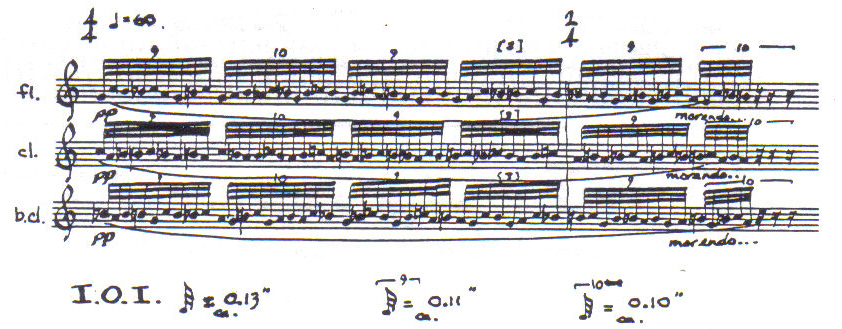
Example 16: Ligeti, Chamber Concerto, I mm. 22 - 23
© B. Schott's Söhne, Mainz, 1974. All Rights Reserved. Used b permission of European American Music Distributors Corporation, sole U.S. and Canadian agent for B. Schott's Söhne, Mainz.
At m.31 of the first movement, woodwinds enter simultaneously on a sustained note (Example 17). When they do begin moving they are in rhythmic unison for one beat, before diverging slightly. The beginning unison strengthens their fusion, which is otherwise slightly weak because the rate of movement is slow. The difference between a quintuplet subdivision and a sextuplet at q = 60 is ca. 0.03", and the density of attacks is a mere 10-16 per beat (and per second). The listener may therefore be able to perceive the specific rhythm of the 5:6 and 5:6:7 ratios. Further fusion is provided by a brief unison pause, as well as by a common dynamic shaping.
In m.39 of the second movement, a high-pitched cluster suddenly appears at If in six instruments. The instruments are tightly fused, moving quite erratically with an alternation of very fast movement and sustained notes, all accented and con fuoco. As the line continues, the activity increases until the sustained notes are dropped altogether and the movement becomes relentless in regular durations of ca. 0.11". Gradually the volume decreases and durations lengthen until they are almost 1.5". The passage is approximately 1'30" in its entirety, with the slowing down beginning halfway through. The effect of the regularity and the absence of dissonance between mm. 50-58 is quite striking in the context of the overall arhythmic nature of this work. The passage is followed by a very brief episode of further periodicity, contrasted by speed: the four upper strings play very fast notes (ca. 0.09" duration) in rhythmic unison.

Example 17: Ligeti, Chamber Concerto, I mm. 30 - 34
Periodicity in the Delineation of Textural Strata
One of the main purposes of this study has been to investigate the interaction of strata in complex works. A few of the more striking examples of multiple strata give an idea of the way in which the composers create an effect of separation between layers. The distinction between stratum, layer, and strand is not always clearly defined, but I reserve their use in the discussion for phenomena of very fast rates of presentation. However, the study of auditory streaming can also benefit from an understanding of our modes of perception for larger-scale organizations. It emphasizes our tendency to group sounds by their interconnectedness rather than by coexistence in time. We can easily adopt a "horizontal" listening approach when the context encourages it.37 The development of harmony in Western music has focused attention on vertical combinations; harmonic structure is a result of careful design which can override a more natural tendency to segregate component strands by registral segregation, dynamic variation, etc. Bregman suggests that the auditory system is designed to integrate sounds that probably arose from the same source.38 The audibility of stratification on a larger scale depends on the success of the composer in creating and maintaining distinction between layers, and on the interpreters' ability to emphasize those distinctions as necessary.
Contrast at some level(s) is essential to the delineation of strata. It might therefore appear that the most efficient way of differentiating layers is to have them contrasted in as many ways as possible: by register, pitch collection, durations, articulation, dynamics, and timbre. Extremes of contrast in all parameters, however, would produce tedium and lack of formal coherence. More typically, a few parameters are contrasted while others retain similarity. Registral separation is one of the key factors of delineation in auditory streaming, and figures prominently in many cases of stratification. Its role in stratification is simply the converse of its (Ole in textures, where the sharing of the same registral band enhances fusion. If there is alignment at the level of pulse and super-pulse, a contrast of density or note activity between component lines does not necessarily produce segregation. A melodic passage may exhibit an interlocking design in which some instruments are restricted to a reinforcement of important pitch and/or rhythmic structure of a melody, while others have a high density of notes in the form of embellishment. However, non-alignment at the levels of pulse and/or super-pulse becomes a significant factor in encouraging a stratified mode of hearing. The works examined here incorporate passages whose layers are differentiated by a variety of methods. In some cases, the distinction between layers is subtle, and becomes blurred at certain points. This attribute should not be interpreted as a failure to achieve stratification, but rather as a sophisticated way of providing variety and depth within the structure.
A clear stratification occurs in the second movement of Lutoslawski's work, at m.311 (Example 18). The main theme is presented in the trumpets, and quasi legato. It incorporates long sustained notes and a few short durations initially presented in a type of neighbor-note figure. The phrases are of irregular length, but have a common denominator of a dotted half duration, and an average length of five dotted halves. The figure is quite recognizable and easy to distinguish. Contrasting sharply with this theme is a bold angular fragment proceeding in short regular durations. It recurs periodically at first, but the period of recurrence is dissonant with the grouping levels of the theme. The two strata begin together, but within a couple of reiterations of the brass figure, it becomes apparent that there is no correspondence between the two. Further dissonance occurs at subdivision levels as oboes and clarinets present a slowly-descending line. That line, clearly audible due to its stepwise movement, presents a duple division of the half-note period. Although the main theme is not periodic, its groupings seemed consonant with the triple subdivision earlier, and are unlikely to be reinterpreted. The complexities of this passage continue as the main theme is treated quasi-canonically and new layers also appear. Although the number of layers increases, the durations incorporated in the new figures are closely related to existing durations. Thus, they form links with the other layers on the level of pulse or super-pulse, presenting variety through grouping or subdivision levels.
The passacaglia in Movement III of the same work presents a fascinating example of an extended multi-strata section. The Passacaglia proper lasts for almost six minutes (to m.562), and is clearly separated from the next section of the movement. During this time, the ground of 8 bars' length is heard 18 times. The passacaglia theme is presented in various orchestrations, incorporates a steady registral climb, and has a dynamic shape which rises to its highest levels on the tenth, fourteenth, and fifteenth statements, then decreases quickly in the end. The dynamic increase is not gradual, but stepped: each of the first ten statements increases the dynamic level on the first beat of the first bar. This helps the listener maintain track of the passacaglia theme.
Example 18a: Lutoslawski, Concerto for Orchestra, II, 307-314
Reprinted by Permission of Edition Wilhelm Hansen / Chester Music New York, Inc. (ASCAP) All Rights Reserved.
Example 18b: Lutoslawski, Concerto for Orchestra, II, 323-327
Reprinted by Permission of Edition Wilhelm Hansen / Chester Music New York, Inc. (ASCAP) All Rights Reserved.

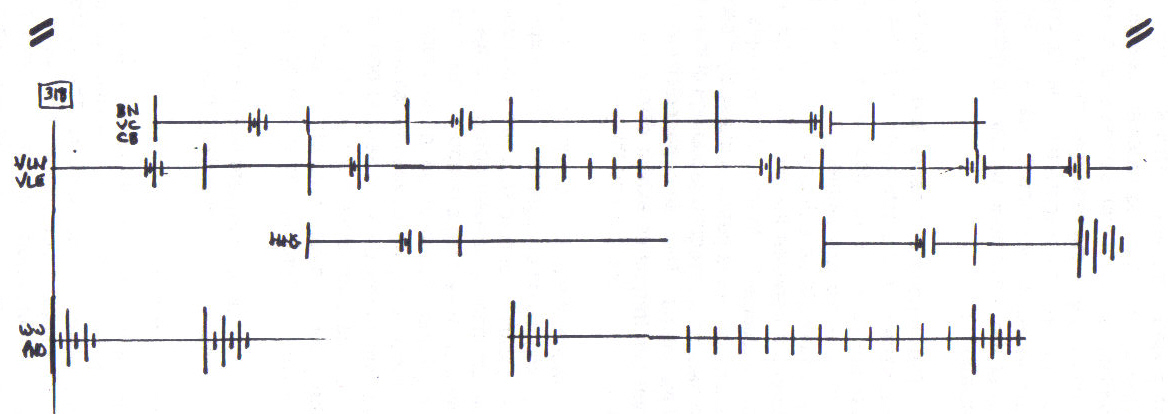
Example 18c: Lutoslawski, Concerto for Orchestra, II, 311-3124
Reprinted by Permission of Edition Wilhelm Hansen / Chester Music New York, Inc. (ASCAP) All Rights Reserved.
There is some variation in the tempo, and the changes do not coincide with the beginnings of ground statements. This is just one indication of the discrepancy between the ground and the other coexisting musical material. Although Stucky refers to these other themes as "variations," I feel that is a misleading term.39 It implies a connection which seems antithetic to the nature of the passage. What is striking about this section is the refusal of the composer to weave the disparate elements together into a whole. Only the fact that we hear them simultaneously links them together. The term "variation" seems more suitable for later sections of the movement, where the ground theme itself is subject to variations in rhythm, articulation, etc.
The various fragments and melodies which appear during this first section exhibit a wide variety of characteristics (Example 19). Periodicity rarely extends to a level beyond that of the super-pulse. Most of the fragments share the same pulse as that of the 3/4 meter of the passacaglia theme. This results in a 2:3 dissonance every time the theme reaches one of its duple bars (fourth and eighth). More significant dissonance results from a lack of alignment between the grouping levels and/or subdivisions of the fragments with those of the passacaglia theme. An example is at m.498 (Example 19h) where a clearly-articulated half-note period is markedly dissonant with the dotted half periodicity of the theme. More frequently, irregular groupings of the fragments produce the dissonance with the regularity of the theme. The (Ole of periodicity is often that of creating a specific foreground texture, as various fragments exhibit different subdivisions of the quarter note, from triplet eighths to sextuplet sixteenths and thirty-second notes.
Much of the dissonance of this section seems jarring precisely because there is continuous expectation of alignment. Such expectation is reinforced by pattern recurrence, which often suggests a periodic structure which does not then materialize, due to truncations, extensions, interruptions, or even abrupt change (see Examples 19c,e). The expectation of alignment can also arise from a temporary alignment of accents or phrase structure between fragment and ground. For example, a line which finishes quietly on the downbeat of m.479 seems appropriate, and thus leaves the listener completely unprepared for a strident flutter-tongue chord which arrives on the second beat of that bar (Example 19f). When the chord occurs again on the second beat of the next two bars, a listener may try to reinterpret it as relating to the ground's meter in an offbeat pattern. However, that interpretation has to be abandoned when the chord fails to appear again for several bars.


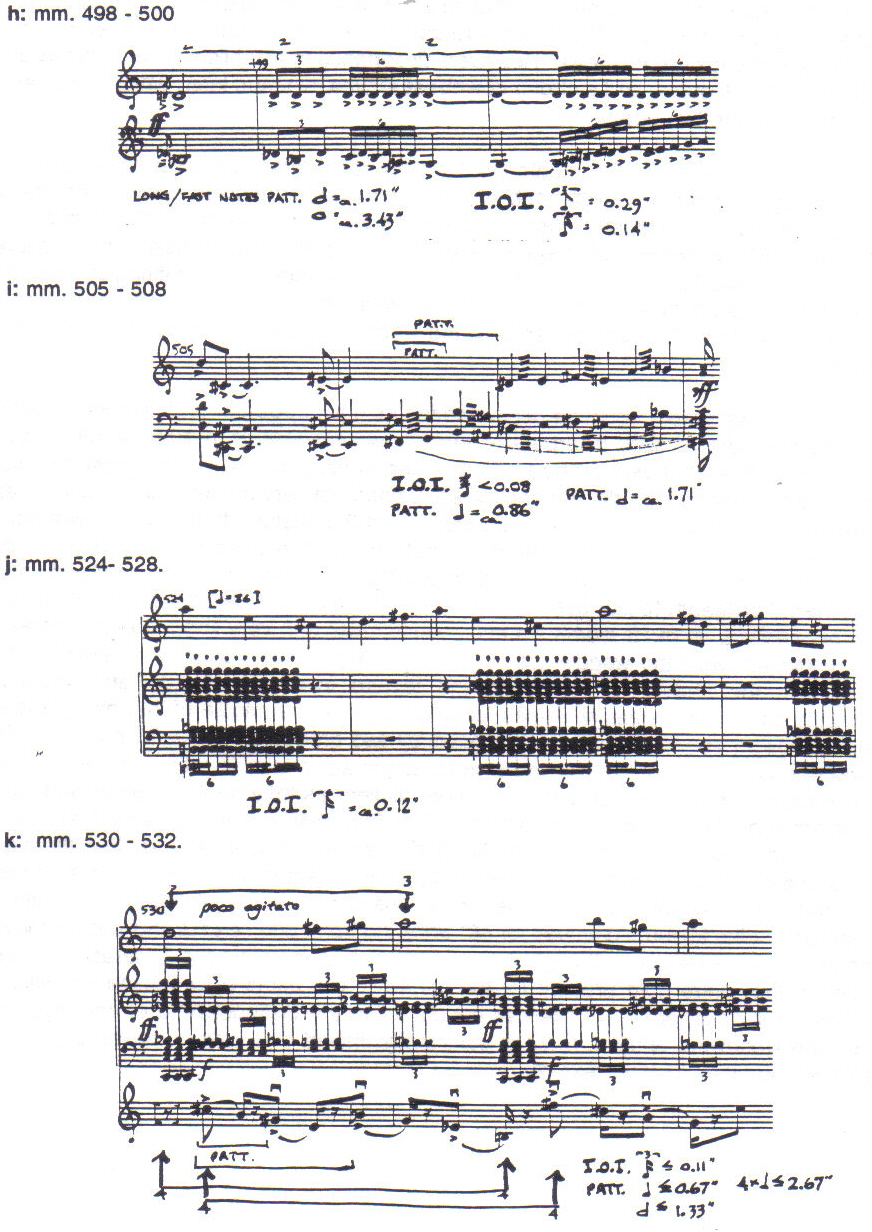
Example 19: Lutoslawski, Concerto for Orchestra, III, excerpts
Reprinted by Permission of Edition Wilhelm Hansen / Chester Music New York, Inc. (ASCAP) All Rights Reserved.
The lack of alignment between the initiation of the fragments with those of the ground statements seems particularly important in creating segregation. The only place where there seems to be alignment is at m.538, where the sixteenth statement of the passacaglia theme begins. The other stratum arrives at a super-pulse period on the downbeat, and the texture changes. However, dissonance is established immediately in the form of a dotted half pulse, and a strong downbeat arrives two bars later, which indicates the independence of the two strata.
Several of the fragments overlap with each other, and usually produce more dissonance by their lack of alignment. That dissonance is usually a result of irregular groupings, and any harshness is perceived more from their individual relationship to the ground. At m.530 however, two fragments present a harsh Type B dissonance (Example 19k). Each is grouped by four, at a displacement of one eighth. This relationship links them more closely to each other than to the theme, with which they are both dissonant. A summary of the non-alignment patterns of the fragments and the theme can be seen in Example 20.
Ligeti's work could be characterized as a juxtaposition and layering of various types of texture, and as such incorporates numerous instances of multiple strata. Many of these are quite brief, but well-defined. Timbre and density are two of the most commonly contrasted parameters. The degree of contrast is often not very marked, and in some cases the blurring of distinction becomes a major element of the design. In the first movement, for instance, a texture which begins in the woodwinds in m.8 is passed to the strings and then provides a background to a horn phrase- (Example 21).The strings move in irregular durations ranging from a sixteenth to just over one quarter. The resultant density averages about six attacks per second. In m.18, trombone and celesta enter with very short bursts of notes "as fast as possible," while the woodwinds play slightly longer bursts a bit more slowly. In the following bar, the density of the woodwind texture increases due to an increase in subdivisions and more overlap of voices (Example 22). In the middle of that bar, piano and harpsichord begin very fast cadenzas, echoed by two groups of strings in a canon effect. The woodwinds, which stopped playing in m.20, begin again in m.22 with another texture, at speeds similar to those they left but much more unified, as they begin together and play in rhythmic unison (see Example 16 above). The fact that many of these textures are closely-knit (i.e. temporally dense and confined to a narrow registral band) defines them quite clearly, and allows the listener to perceive the interplay of textures. In addition, the durations of the textures themselves help delineate the various strata. In the passage just mentioned, the woodwind/string texture continues for 48" while the trombone/celesta and short woodwind fragments last for a mere 8". It might be more difficult to maintain the separation between the layers if they were both present for the full 48". The effect of simultaneous initiation, which has a fusing tendency, is likewise conducive to the distinguishing of one layer from another: the woodwind entry at m.22 is sufficiently unified that it does not readily tolerate merging with another existing texture.
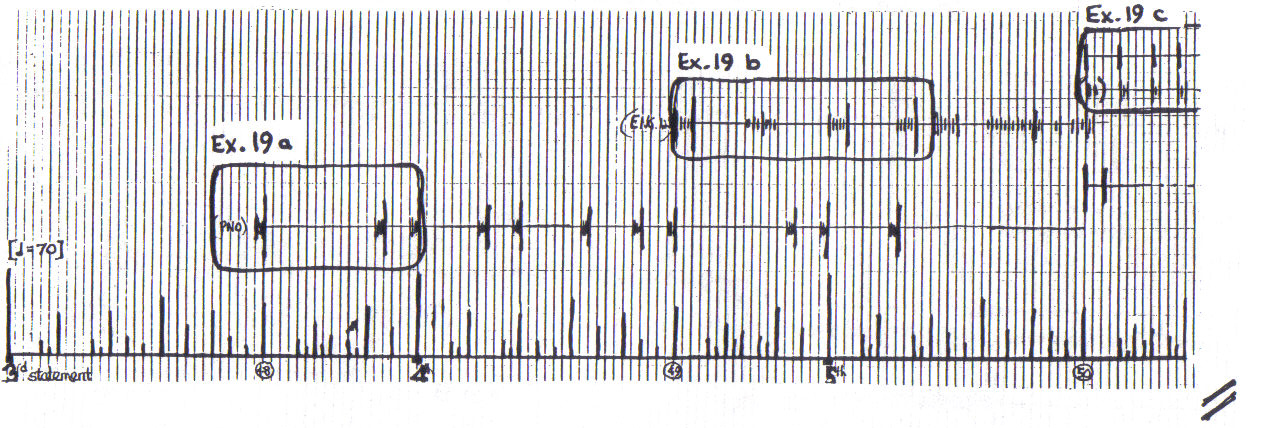
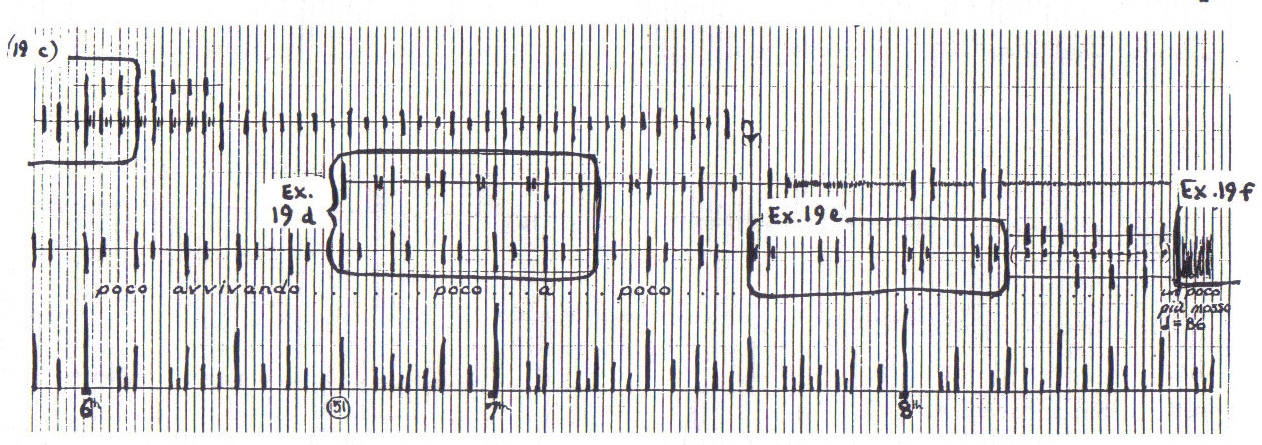
Example 20a: Lutoslawski, Concerto for Orchestra, III, mm. 434-379
Reprinted by Permission of Edition Wilhelm Hansen / Chester Music New York, Inc. (ASCAP) All Rights Reserved.
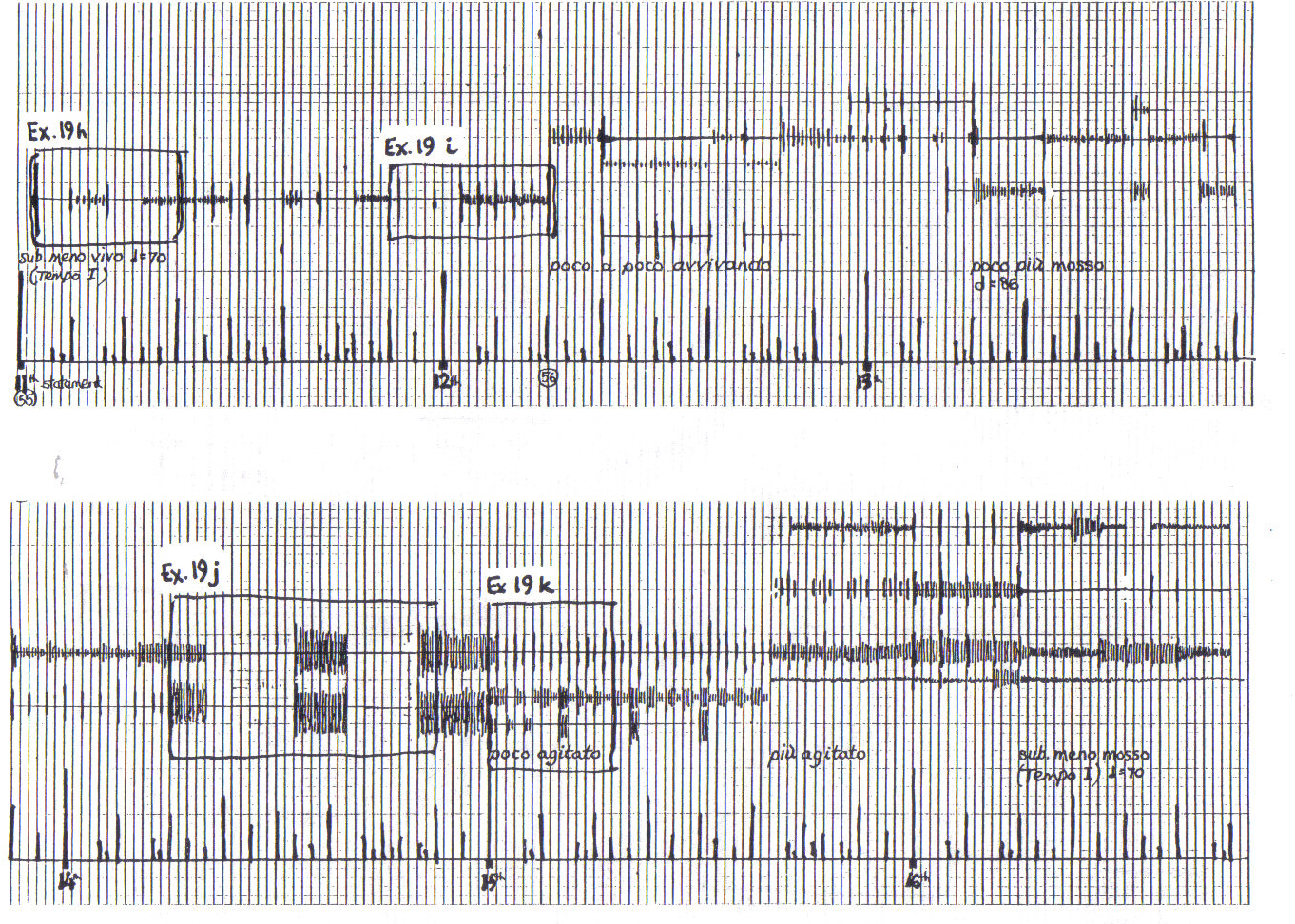
Example 20b: Lutoslawski, Concerto for Orchestra, III, 498-543
Reprinted by Permission of Edition Wilhelm Hansen / Chester Music New York, Inc. (ASCAP) All Rights Reserved.

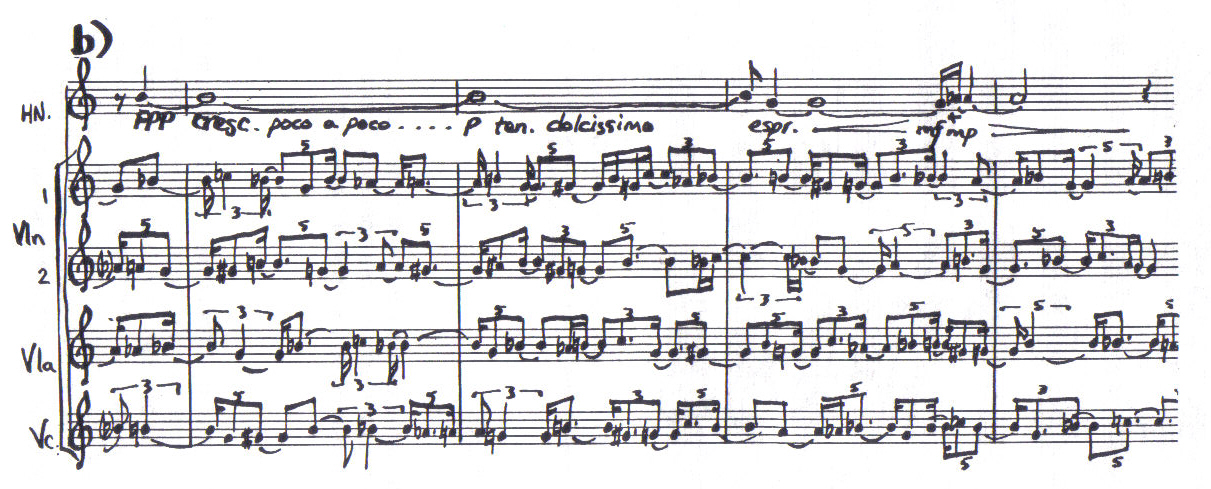
Example 21: Ligeti, Chamber Concerto, I mm 8-16, 14-18
© B. Schott's Söhne, Mainz, 1974. All Rights Reserved. Used b permission of European American Music Distributors Corporation, sole U.S. and Canadian agent for B. Schott's Söhne, Mainz.
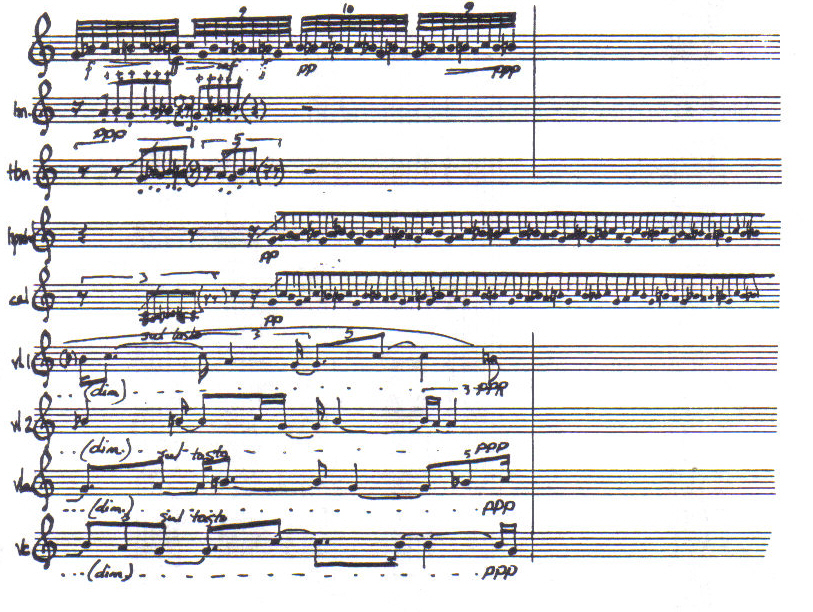
Example 22: Ligeti, Chamber Concerto, I m.19
© B. Schott's Söhne, Mainz, 1974. All Rights Reserved. Used b permission of European American Music Distributors Corporation, sole U.S. and Canadian agent for B. Schott's Söhne, Mainz.
Pulse and Sub-Pulse
Pulse and sub-pulse are present throughout most of the two works analyzed. Significant long-term pulses usually arise from the composite rhythm of several layers which form a rhythmic consonance on the level of pulse or sub-pulse.
Concerto for Orchestra
The additive structure of many of the themes in Lutoslawki's work suggests that pulse might figure prominently in his work. However, one characteristic of several themes of his work is a contrast between very short and very long durations, and in such contexts an audible pulse could interfere with the effect of the sustained notes. In cases where a pulse is incorporated into a theme, the existence of another layer which is dissonant on several hierarchical levels often obscures the original pulse. Therefore, although pulse may help delineate the separation of layers, it is not perceived directly as a structural component.
The work does open, however, with an overt pulse. It is present throughout the "A" sections of the ABA form of the first movement. The pulse is articulated in the form of a drone on F#, and is reiterated for over one minute every 0.75". Its cessation signals the end of the first section, and its re-entry confirms the return of the opening material in m.125. This pulse provides a stabilizer for the irregular length of the theme's phrases: a periodicity which is consonant with most of the various modules and with a sparse pattern in the brass. The few instances of dissonance between theme and pulse are of the foreground variety in the nature of syncopation and displaced accent.
When the pulse stops two bars before the "B" section, it may well sound in the listener's mind through the sixteenth-note motion and even into the first bar of the new theme. However, irregular groupings of eighth notes in the next bar (example 5) interfere with the mental sustaining of that pulse. When the dotted quarter next appears (mm.52-56), its duple grouping is new and thus does not immediately suggest a recurrence; a subsequent pattern in the brass composed of lengthening durations obliterates any remaining feeling of pulse. The dotted quarter period reappears only subtly in a complex texture at m.64 as the level of consonance of two patterns which are dissonant at lower levels. Section "B" continues in this style throughout: many figures remain aligned with a dotted quarter pulse but groupings resulting from accents, contours, and repeating patterns work against its audibility. Only with the reintroduction of the "drone" in m.125 is the pulse firmly reinstated as a structural unit.
Throughout much of the Capriccio of Movement•' I and the return of that material at the end of the movement, there is an unusually fast pulse of a quick quarter note at ca.-0.35". This is complemented in the majority of the section by a super-pulse of a dotted half note (ca. 1.0"). The prominence of the quarter-note pulse recedes in the middle section, due to latent and overt conflicting groupings. A dissonant dotted quarter pulse appears first as a latent grouping in m.200, and then becomes overt with the prominent entry of the third theme in m.208. Later, a five-eighths pattern occurs simultaneously with the quarter-note grouping. In addition, the occasional introduction of a half-note period, though consonant with the quarter, strongly disturbs the established super-pulse, and therefore threatens the general metric stability. The quarter note is absorbed into the dotted half pulse of the Arioso section, which provides the common denominator of the two dissonant strata. The quarter itself is articulated by horns and trombones. However, increasing use of the dotted quarter in other layers creates a dissonance which emphasizes the dotted half as the level of consonance. Only the return to the Capriccio section reinstates the quarter-note pulse.
Although there are components in the various strata of the Passacaglia which can be considered as creating a pulse level, it is often difficult to determine which level would be interpreted as a pulse by the listener, due to the shifting of attention from one level to another. The ground itself incorporates two bars divided by two and six bars divided by three, so the super-pulse period of the bar itself (ca. 2.6") may be sensed as a slow pulse throughout, if one maintains the ground as reference.
This period is reinforced in later treatments of the passacaglia theme. At m.570 (62), the half-note (ca. 0.56") becomes the pulse, and the 4 eighth-note figures which define the half-note period each represent one bar's worth of the ground. Later, at m.852, the pulse, this time a dotted quarter (ca. 0.44") again represents one bar's worth of the original.
However, the next variation, at m.876, owes much of its apparent lopsidedness to the fact that the rhythmic patterns no longer correspond to the original presentation. Every second occurrence of a note which was originally on a downbeat is now clearly in an upbeat position as the third note of a triplet. The period is again that of the half-note, this time at the rate of ca. 0.52". The same period is maintained at m.903 (97), but the rhythm is neutralized by the regularity of the subdivision and the compression of two bars° worth of the ground's pitches into one half-note period. This means that although none of the original downbeats are in upbeat positions, alternate ones are on weak beats. The first variation returns at m.953 for one final statement at the breakneck speed of half-note pulse at ca. 0.38".
Chamber Concerto
In the third movement of Ligeti's work, there are several passages where various pulses coexist. In mm.42-58, the rates of periodicities seem particularly favorable to tracking the pulse of one of the slower instruments, and hearing the others in relation to it (Example 14). The length of the passage itself, and the absence of other more prominent material, provides the listener with the opportunity to choose which pulse to track, and then to change from one to another at will. Of course, it is also possible to avoid focusing on any one instrument and follow the composite texture instead.
In the rest of Ligeti's work, pulse does not figure very prominently, though it does arise in some passages as the first level of alignment of foreground dissonance. In most of these passages, the resultant pulse does not continue for more than a few seconds, and does not link with other coexisting layers or adjacent passages. Therefore pulse does not have a significant function except as a component of that particular textural fragment. However, a similar passage in the fourth movement differs from the others by its extensive duration (almost an entire minute), and by its lack of distractors. The passage consists of an increasing number of instruments playing a variety of subdivisions of the beat. The material which does not belong to that layer consists mainly of sustained notes which do not clash significantly. The pulse is still not very strong, though, mainly because the contours of the various component parts form patterns which do not coincide with the beat. As these contours become more jagged (mm.42-50) and the patterns become more regular (mm. 46,49), the sense of pulse becomes obliterated.
In ambiguous cases, interpretation can weight the perceptual effect. Otherwise, the emphasis on the super-pulse period can help unify the structure, since those periods emphasize the alignment of theme and accompaniment. In simple textures, periodicities are usually quite easy to notice and emphasis can make them too blatant. In complex textures, however, stressing the periodic elements especially at the pulse and bar level can help the listener organize the variety of data.
Large-Scale Structure
After a careful study of the periodicities of different works, it seems clear that the formal structure emerges most often from the degree of contrast both within and between passages. The roles of periodicity in the large-scale structure of these two works are chiefly manifest at the foreground. This bears out observations by Clarke, who suggests:
In tonal/metric music, formal boundaries are conveyed by means of relatively abstract musical properties (e.g. cadence, key change, melodic repetition). In contemporary music motivic repetition may function in the same way, but the absence of a generally shared set of compositional procedures indicates that rather more immediate parametric changes (e.g. changes in register, pitch, density, timbre, rate of activity) are probably decisive in establishing large-scale boundaries.40
A main factor in delineation of structure was traditionally provided by the appearance or reappearance of a theme. Even in contemporary works, the appearance of a familiar theme or gesture remains a very strong indicator of structure. Periodicity often has a fundamental (Ole in promoting our recognition of a theme. When a pitch/rhythm configuration is recognized as a distinct identity, it will emerge quickly from any surrounding material.41 In most cases, a theme will begin at its beginning, and thus imply initiation of a new section.42
Structure can be well-delineated by means of very audible boundaries, or it can emerge from a more fluid metamorphosis from one section to another. Audible boundaries can be immediate or stretch over a short period of time. An immediately perceptible boundary is likely to incorporate a sudden change in periodic structure or other parameters. A different sense can arise from an anticipated boundary, where tension is decreased gradually towards the boundary and gradually increased again into a new section. This is a more traditional approach, and is compatible with the perception of hierarchically ordered period structure. However, there are many signals for a decrease in tension which are not dependent on hierarchical metric organization. Rhythmic factors include a decrease in temporal density, a resolution of rhythmic dissonance, and a lessening of contrasts.
Concerto for Orchestra
Lutoslawski's work shows a variety of techniques for creating structural boundaries. Broadly speaking, the first movement is the most clearly and simply segmented, while the third has more variety of section lengths and ways of demarcating them. The work incorporates many themes and fragments which are readily identifiable, and therefore the appearance or reappearance of any of these can serve to signal the beginning of another section. Lutoslawski also makes extensive use of contrast in the other parameters of texture, timbre, temporal density, register and dynamics. Pitch structure is less contrasted than most other parameters, and could be thought of as a unifying force. This is visible not only in the predominant use of the passacaglia theme throughout the third movement, but also in the transformation of the second theme from Movement II, and of the theme from Movement I into a new theme in Movement III (example 23b), and in the close relationship between contours in fragments from many of the themes.43

Example 23a: Lutoslawski, Concerto for Orchestra, I, mm. 40-43
Reprinted by Permission of Edition Wilhelm Hansen / Chester Music New York Inc. (ASCAP) All Rights Reserved.
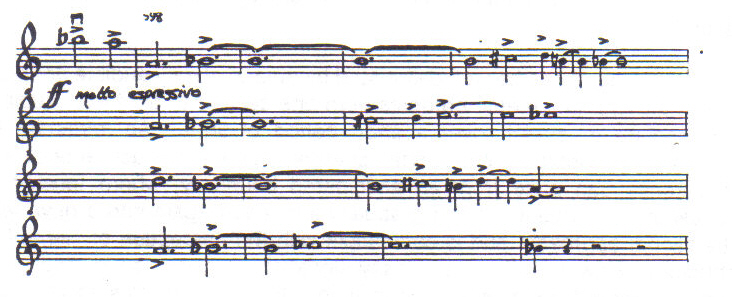
Example 23b: Lutoslawski, Concerto for Orchestra, Ill, mm. 597 - 614
Reprinted by Permission of Edition Wilhelm Hansen / Chester Music New York Inc. (ASCAP) All Rights Reserved.
The first movement of the Concerto for Orchestra is in a clear ABA form. The A sections are fugal and are therefore undivided, except by the various entries of voices. A figure in the horns is periodic, but dissonant with the other strata; this dissonance is not acute due to the short duration of the figure itself and the length of the intervening rests. The drone pulse provides continuity throughout. The two-bar boundary between the main sections A and B is clearly delineated through a logarithmic increase in note density, combined with an increase of dynamics, followed by a brief silence of ca.0.50". The change is heightened by the absence of the strings timbre and pulse reiteration during those bars.
The B sections are much more complex, and consist of several subsections of three basic types in the general form abcabca. The first two statements of the "a" theme and texture are roughly the same duration (ca. 2T -and 25"), whereas the third statement is twice as long (ca. 54"). The intervening material corresponds exactly to these durations: it lasts for ca. 27" the first time and ca. 56" the second time, however, the listener is more likely to be aware of the differences which fill those durations than of their equivalence. Contrast between the subsections of B involves density of note attacks, change of period lengths, and levels of rhythmic dissonance. In addition, the repetition of entire sub-sections creates expectations of parallel structuring and thereby allows the listener to anticipate boundaries.
Movement II is in several sections, and has a basic AABA form. Both sections involve multiple layers, but the "A" sections are much more segmented, while the "B" section is unified by the presence of a slow melodic theme. The "A" sections involve repetition of elements on a wide range of levels, from the quarter note to large sections. A high degree of irregularity of grouping structure is balanced by a nearly-constant articulation of a bar period (ca. .1.0") and by nearly exact repetition at immediate or later points in the movement. Each "A" consists of the subsections abcdeb which are scarcely altered on their reappearances.
The "a" theme has a slightly ethereal quality that is reminiscent of a passage in the final movement of the composer's string quartet.44 It causes the listener to strain to catch the music. This effect is a result of the extreme speed, relatively high register, and very soft dynamics. The rate at which the theme moves is normally associated with more ornamental roles such as embellishment. An interpretation of ornamental function is however prevented by the definite shape of the theme and the absence of any other activity. That shape is emphasized by the four repeated sixteenths at the beginning of each phrase, and thrown into greater relief by the sudden rests and irregular phrase lengths. Nevertheless, the listener may not grasp the structure for the first few phrases, due to the speed of presentation and its novelty. There is some compensation for this effect by the incorporation of a high degree of redundancy in each phrase and between phrases (Example 24).
The main periodic aspect which delineates section "a" from the preceding movement and following sub-section is the very fast durations which operate in isolation to convey the theme. Sub-sections "b," "c," "d," and "e" are differentiated rhythmically mainly by grouping structure, which becomes increasingly more complex (Example 25.) The "d" and "e" sub-sections each contain dissonant layers. Those of "d" align on the two-bar level, while those of "e" are more dissonant but exhibit some alignment at the period of ten eighths. A final statement of the "b" sub-section is extended by fragments and rests into an increasingly sparse texture which disturbs the sense of pulse and culminates in silence of about 1" before converging sixteenth lines return us to the "a" subsection once more.
Apart from a quasi-canonic addition to the "a" sub-section, and a five-bar extension to "d," the repetition of the entire section is scarcely changed except for orchestration. The complicated juxtaposition of periodicities and irregular groupings helps maintain the vitality through the repetition, while conversely the repetition helps the listener grasp the more subtle relationships between the various rhythmic structures.
As sub-section "b" exhibits the clearest articulation of the dotted-half ![]() super-pulse,
it
is appropriate that it precedes the middle section (B) of the movement. As
discussed in the delineation of textural strata, the period of the dotted half
is the common denominator of the two strata
at the opening of that section. Therefore, the contrast between
sections
A
and
B
exists not on the level of the super-pulse, but rather on the grouping levels
and
through the contrast in durations. The melody at
B
incorporates
sustained notes and
strong. This provides further contrast when the A
section reappears with its sixteenth-note movement. The final "b"
sub-section of the movement has extra bars inserted between the
bar-length fragments. These frame an unusual pianissimo percussion
passage formed out of increasingly
short timbral palindromes in quarter notes. The inserted bars effectively slow
the motion, as is appropriate to the end of a movement.
super-pulse,
it
is appropriate that it precedes the middle section (B) of the movement. As
discussed in the delineation of textural strata, the period of the dotted half
is the common denominator of the two strata
at the opening of that section. Therefore, the contrast between
sections
A
and
B
exists not on the level of the super-pulse, but rather on the grouping levels
and
through the contrast in durations. The melody at
B
incorporates
sustained notes and
strong. This provides further contrast when the A
section reappears with its sixteenth-note movement. The final "b"
sub-section of the movement has extra bars inserted between the
bar-length fragments. These frame an unusual pianissimo percussion
passage formed out of increasingly
short timbral palindromes in quarter notes. The inserted bars effectively slow
the motion, as is appropriate to the end of a movement.
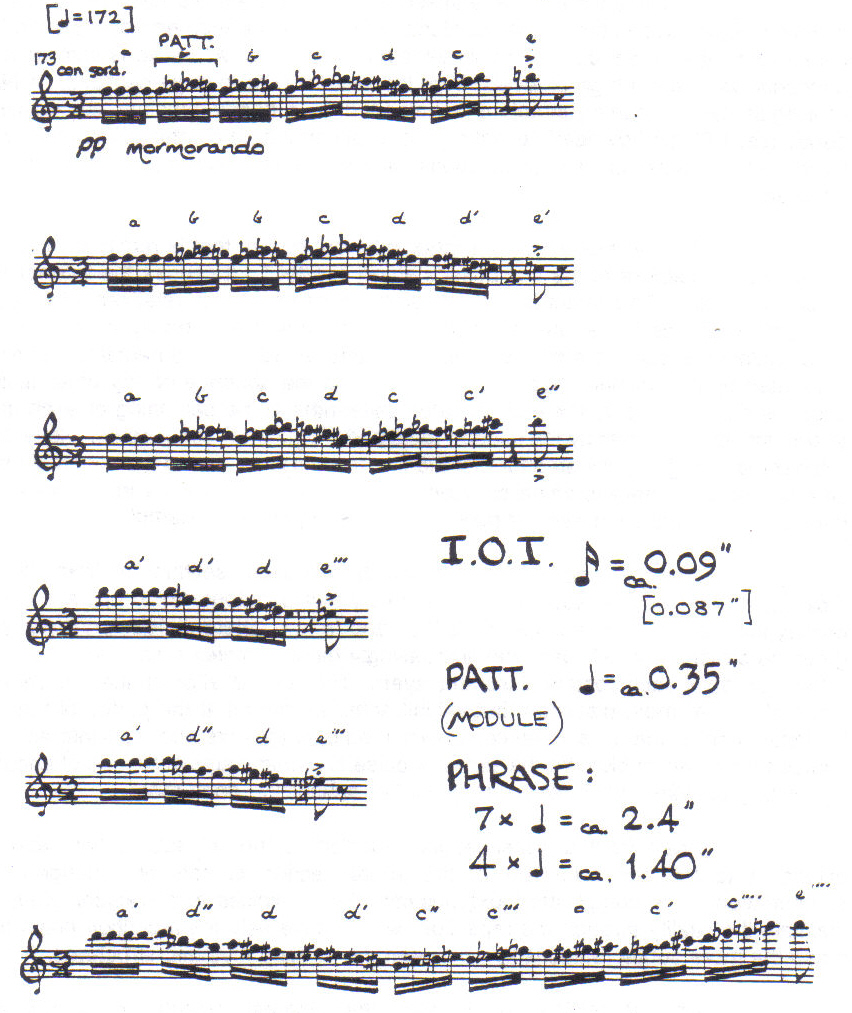
Example 24: Lutoslawski, Concerto for Orchestra, II mm. 173 - 189
Reprinted by Permission of Edition Wilhelm Hansen / Chester Music New York Inc. (ASCAP) All Rights Reserved.
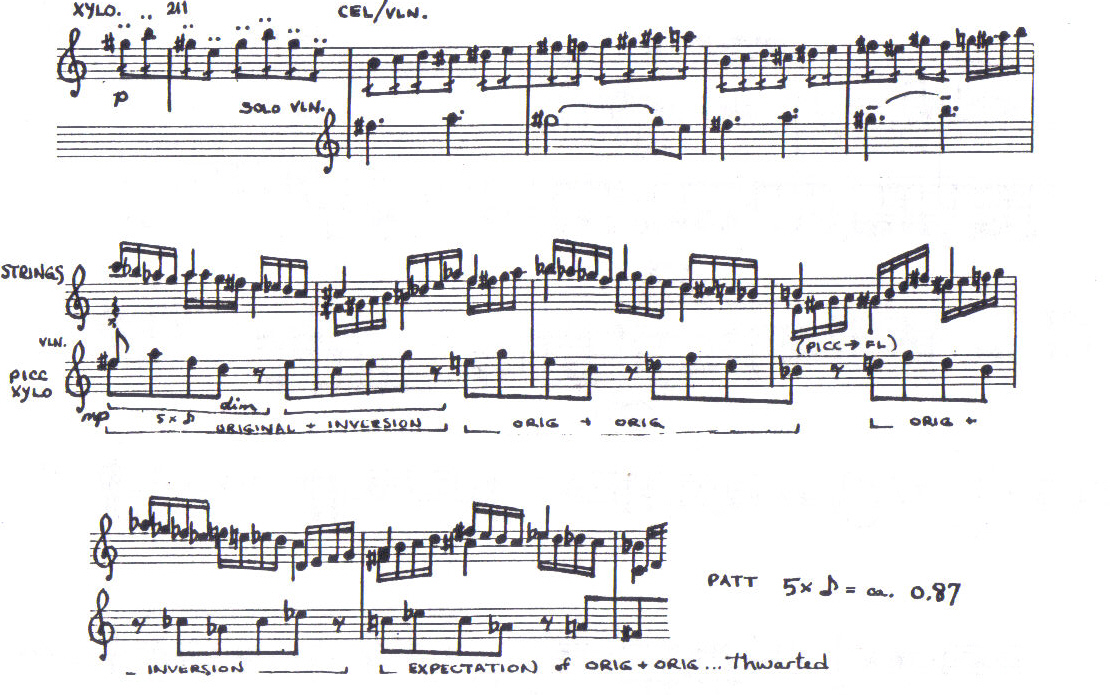
Example 25a: Lutoslawski, Concerto for Orchestra, II mm. 189 - 210
Reprinted by Permission of Edition Wilhelm Hansen / Chester Music New York Inc. (ASCAP) All Rights Reserved.
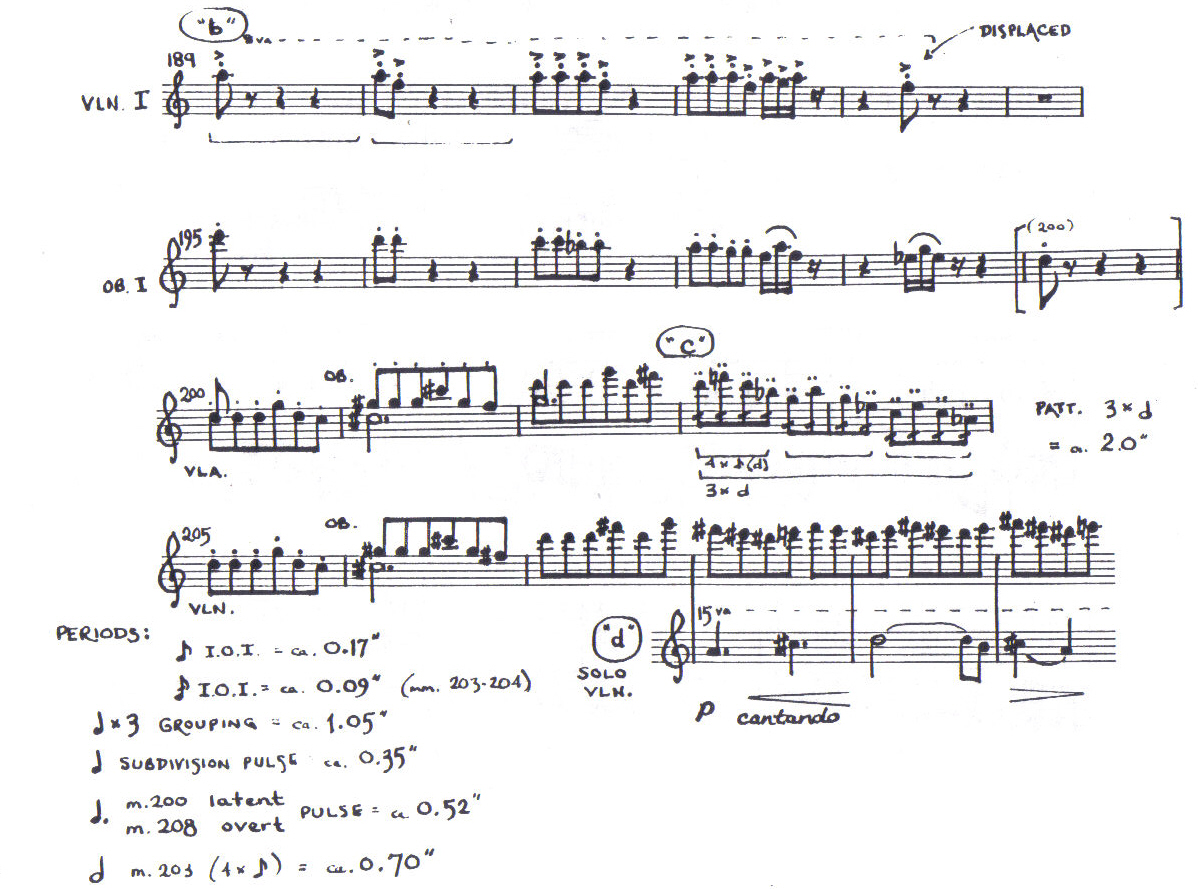
Example 25b: Lutoslawski, Concerto for Orchestra, II mm. 210-222
Reprinted by Permission of Edition Wilhelm Hansen / Chester Music New York Inc. (ASCAP) All Rights Reserved.
The beginning of the passacaglia does not exhibit very marked contrast with the end of the previous movement, as the register and dynamics are the same. The fact that the last note of the second movement and the first note of the third are both double bass pizzicato indicates that this lack of contrast is quite deliberate. The boundary between the two movements is therefore created by the lack of tension; the passacaglia theme remains very low in density for the first eight bars. As discussed above, the passacaglia clearly manifests a high degree of activity on both large and small scales. It ends on a very low level of energy, both in temporal density and in dynamics.
The remainder of the third movement is very active, with many different layers and juxtapositions. There are many silences which do not function as structural boundaries but rather as interruptions, thus adding tension to the passage. These interruptions correspond to "gaps" mentioned by Lerdahl & Jackendoff and Benjamin,45 in which the internal measuring of duration stops, and is restarted only on hearing the next sound. The opening of the section following the passacaglia is an introduction to this technique. An opening gesture is repeated three times with intervening gaps of silence before the theme begins. This technique accumulates significant amounts of potential energy to be released with the downbeat of m.570. The reasonably fast rate of periodicity in the gestures accentuates the gaps; the rate of note attacks combined with the registral distance traversed imply a certain degree of energy, and thus imply the strength of the opposing force which is capable of stopping the forward motion. A comment by the composer about a different work (Mi7parti) seems equally appropriate here:
the way it is repeated three times, seems in tune with the psychological flow of the form. One needs to draw a deep breath before tackling a piece which is played without a break over quite a long stretch of time; the beginning is repeated three times for the piece to gather momentum. This device of not quite reaching the climax is often used in compositions which need 'deep breath'. It's easier to remember and absorb something new if this something is repeated from the beginning. It's a classical trick.46
Four layers are present at the beginning of the second section of this final movement: the first variation of the passacaglia theme, a quarter-note quasi-ostinato, the eighth-note figure from the opening, and irregularly-spaced chords. These are all consonant at the levels of quarter and half notes, but dissonant at higher levels due to irregular groupings. Both the ostinato and the passacagiia variation tend to be grouped either by two or three halves, delineated by pattern repetition. The other two layers are more irregular. As the figure from the opening has an anacrusic character, it conveys anticipation of a downbeat. The chords are more jarring, as they present equivalent accents, but without warning. After about 45", most of the motion is interrupted by a three-bar palindromic texture (example 4 above). It serves to focus the listeners attention for the upcoming change, although one bar of the former passage intervenes before that change takes place. A brief rest is the first since the gaps of the opening, and in this case does serve as an indicator of a boundary. The new section is contrasted initially by a complete change in duration to unaccompanied half-notes. At the downbeat, a well-defined textural passage begins as accompaniment to the theme. The texture (example 1 above) moves in eighths and quarters, whereas the theme moves mainly in long durations. However, the inner consonance of the texture and the lack of similarity between periods seems to soften the sense of dissonance, despite a clear stratification, and so this section provides a strong contrast to the preceding one.
The same theme and accompaniment appear again at m.659 (about one minute later). After the first statement, there is a type of bridge passage which establishes grouping periods anticipating those of the subsequent passage. The melody is repeated four times with an extension on the fourth bar. Apart from a possible sense of indirect dissonance provided by the alternation of meters, there is no dissonance in this passage. The remaining part of the passage is much more developmental, and involves layering. First this is confined to fragments of the preceding theme, but in m.646 a very audible descending line appears in half notes in the brass. The periodic quality and rate of presentation (ca. 0.5") contribute significantly to the audibility of the line.
The second presentation of theme and texture leads to the chorale theme. The texture grows sparser until, in m.675, the patterns cease and the pulse is maintained by the flutes (eighth and quarter) and trumpets (half note). The melodic line has reached its final notes and is heard only in the violins. After two bars, half notes are periodically substituted for the eighth-note movement in the flutes; after two more bars all eighths and quarters disappear, leaving only repeating halves. This procedure effectively slows the pulse from eighth to half, in preparation for the first appearance of the chorale theme.
The chorale is presented in counterpoint with another faster-moving lyrical theme, which is accompanied by increasingly complex textures (example 8). Due to a highly redundant phrase structure in each of the two themes, and a fixed relationship between the two, the dissonances between them seem quite mild. They consist mainly of textural surface dissonances, canonic imitation of the secondary theme, and an internal irregularity in the phrase structure of the chorale theme itself. The chorale section lasts for over one and a half minutes in its first statement; the entire phrase is repeated three times, with the hemiola of the last phrase extended farther each time, accompanied by texture. It appears again towards the end of the work (at m.922), but is stated only once at that point. In that final statement, the extension is not as substantial as before, but the main theme itself is accompanied by much more intricate textures in place of the secondary theme.
The rest of the movement is characterized by previously-heard material in various developmental treatments, with various degrees of dissonance and various densities of note attacks. A reduction of tension precedes a change of texture in m.903. This texture begins with a slow quasi-canonic passage in a low register and gradually over half a minute and through a variety of textural devices grows to a shrill tremolo in woodwinds and strings. The tremolo chord coincides with the final reference to the chorale theme. Finally, an abrupt change is caused by the return of an ostinato figure at Presto, with irregular punctuation by the opening gesture figure. This is followed by a sudden and dramatic change of durations, from ca. 0.09" to ca. 1.3", for a few seconds, before a final rush in short durations to the finish.
Chamber Concerto
Ligeti's work exhibits considerable fluidity of structural form. However, there are instances of very stark boundaries. The overall shape of each movement exhibits contrast on several levels. The first movement begins with an extremely restricted registral range: all instruments play in the same mid-range cluster. There is a slightly wider range of contrast in durations, and the durational values are medium. A similar image is produced by a longer temporal focus: the overall degree of contrast for the first minute is medium, with several little increases in activity mirrored by fewer, greater increases. For example, a burst of activity occurs at A, as the strings enter with a much wider range of durations and articulation; this disappears quickly and a balance is "restored" by a reduction in degree of contrast for the next several seconds. Similarly, the melodic fragment played by the horn presents a very marked contrast in duration, and leads into a section of marked contrast in the opposite direction, with very short durations in the woodwinds. With the initiation of the "canonic" entry pairs, the durational contrast is again sharply reduced, but this is balanced by the high rate of activity
The range of large-scale contrast gradually increases, and the degree of cohesion between components of each layer seems to increase. The strings layer becomes very loud and immediately very soft, before turning into unison trills. The tension accumulating from the restrictions of the narrow registral band is thus further increased, and the listener's attention is focused in anticipation. Suddenly in m.38, all instruments play an E flat in a six-octave spread. In retrospect, it seems an obvious solution to the build-up of energy, but. it is still rather startling, and certainly dramatic. The sonority clearly announces a change, as it would be difficult to conceive of a return after such a gesture. The tension is built up again slightly, by sheer refusal of the sonority to disappear over a 45" period, although the texture is enriched by a few added tones. A brief multi-strata passage follows, before the texture reduces again to a single strand. This time the layer is composed of a rumbling in a very low registral band, as restricted as that of the opening but with a different effect, due both to the muddiness of the register itself and to the fast periodic rates and heterophony employed. The movement ends with a texture which is comprised of four lines exhibiting considerable foreground dissonance.
The second movement begins with contrast in activity, in the form of another sustained sonority. This is not as stark as the open octaves of the first movement, and changes more quickly. Soon, another more complex texture emerges, involving all instruments for over a minute's duration. It is characterized by a greater degree of contrast in durational values; although it is still confined to a medium span of durations, the fluctuations between the extremes are much faster than in the first movement. The texture ends conventionally with a reduction in density, until only a few instruments are playing sustained notes. A change in pitches and dynamics leads to expectations of a new section. The contrast is startling because by repeating a gesture from the first movement in the form of another sustained sonority, though this time it is a tritone instead of pure octaves. The next texture begins as a leap from this sonority to a high cluster, and a rather strident passage begins which is characterized by rhythmic unison. The activity in this layer increases and decreases again. Accompanying the reduction in constant activity is a loosening of the registral band limits, and a sense of releasing tension is experienced as the pitches become more discernable by their separation. A bridge passage is formed by the sudden change in string durations to a fast but periodic rhythmic unison, leading to the final chord which closes the movement.
The third movement contrasts with the final sustained sonority of the previous movement by its fast reiteration of fixed pitches. As the entire movement is constructed of periodic reiterations at various rates, it could be said that there is little internal contrast of durations within any one strand in a short period of time. However, there is considerable variety in the specific rate of the various periods, the overall length of the various textures, in the overlap of those textures, and in the grouping durations produced by accents of group initiations, dynamics, and pitch changes. The similarity between the various textures in this movement provides contrast at the higher level with the other movements.
The sparse texture and notated silence which end the third movement add an emphasis to the active beginning of the fourth. The constant foreground dissonance of the previous movement is also contrasted, through\ a rhythmic unison of thirty-second notes in two clarinets. In retrospect, the relative lack of differentiation in some parameters of the third movement is a preparation for the extremes of contrast provided in the final one. The first minute of the movement is characterized by long warbling phrases in various pairs of instruments and at various rates, all relatively fast. A pause in this movement is provided by trills in harpsichord and piano alone, leading to a strange duet with bass clarinet playing very fast periodic durations with doubling on piccolo five octaves above. This strand develops into a thicker texture, though without contrast of durational values. A horn/piccolo cadenza emerges from this texture at the same time as the pianist begins a frantic hammering. The cadenza is full of durational and pitch contrasts, and is quite easily distinguishable from the piano. However, it is outlasted by the piano, which plays for several seconds alone before stopping suddenly, to be replaced by the double bass's "feroce, impetuoso" line. The linear texture which began the movement is thus re-established, and although the contour becomes increasingly jagged, it turns into arpeggio figures. In conjunction with the periodicity on the sub-pulse level, these figures contribute a static quality which balance the extremes of movement. As before, the lines become trills which reduce the activity and, being this time in a mid-range, help release the tension as the movement draws to a close. An extremely loud and feroce gesture in the woodwinds is answered by a very audible trombone glissando and a few almost inaudible oscillations on woodwinds and keyboards.
Bibliography
Batstone, Philip. "Musical Analysis as Phenomenology," Perspectives of New Music, 7/2 (1969; - 110.
Benjamin, Walter. "A Theory of Musical Meter," Music Perception 1 (1984): 355 - 413.Berrry, Wallace. "Metric and Rhythmic Articulation in Music," Music Theory Spectrum 7 (1985) 33.
___________ . Musical Structure and Performance. New Haven: Yale University Press, 1989.
___________ . Structural Functions in Music. Englewood Cliffs, N.J.: Prentice-Hall, Inc., 1976
Bersano, James Richard. "Formalized Aspect Analysis of Sound Texture". Ph.D. diss., Indi University, 1980.
Bielawski, Ludwik. "The Zones of Time in Music and Human Activity," The Study of Time 4 (19 173 - 179.
Boltz, Marilyn. Time judgments of musical endings: Effects of expectancies on the 'filled intE effect'," Perception & Psychophysics 46/5 (1989): 409 - 418.
Boretz, Benjamin. "In Quest of the Rhythmic Genius," special issue of Perspectives of New Mt 9/10 (1971): 149 - 155.
Boretz, Benjamin, Harold Oliver, Barney Childs, and Charles Whittenberg. "The Nature of Contir in Music," Proceedings of the American Society of University Composers, v.6 (1971): 49 - 8
Boulez, Pierre. "Form," text of a course given at Darmstadt in 1960; reprinted in Orientatio collected writings of Pierre Boulez: 90 - 96.
___________ . "Timbre and composition - timbre and language," Contemporary Music Review (1987): 161 - 171.
___________ . "Time, Notation and Coding" from a lecture given at Darmstadt in 1960; reprint Orientations: collected § writings of Pierre Boule: 84 89.
Bregman, Albert S. "Analyzing Spectra That Won't Stand Still," Canadian University Music F (1982): 31 - 48.______ . Auditory Scene Analysis: The Perceptual Organization of Sound. Cambrid The MIT Press, 1990.
__________ . "Auditory streaming: Competition among alternative organizations," Pen Psychophysics, 23 (1978): 391 - 398.
_____________ "Fusion of auditory components: Effects of the frequency of amplitude r Perception & Psychophysics, 47 (1990): 68-73.
Brower, Candace. "Memory and the Perception of Rhythm," Music Theory Spectrum 1993): 19-35.
Bulter, David. The Musician's Guide to Perception and Cognition. New York: Schirm(
Carter, Elliott. "Music and the Time Screen," pp. 63-88 of Current Thought in Mu University of Texas Press, 1976).
Childs Barney. "Time and Music: A Composar's View," Perspectives of New Music, 15/2 (1977):194 - 219.
Clarke, David. "Structural, cognitive and semiotic aspects of the musical present," Contemporary Music Review 3/1 (1989): 111 - 131.
Clarke, Eric C. "Levels of Structure in the Organization of Musical Time," Contemporary Music Review 211 (1987): 211 - 238.
____________________ . "Mind the gap: formal structures and psychological processes in music," Contemporary Music Review 3/1 (1989): 1 •13.
______________________ . "Some aspects of rhythm and expression in performances of Erik Satie's 'Gnossienne No. 5', Music Perception 2/3, (1985): 299 - 328.
__________________________ . "Structure and Expression in Rhythmic Performance," Musical Structure and Cognition, (1985): 209 - 236.
Clifton, Thomas. "Music as Constituted Object," Music and Man 2 (1976): 73 - 98.
_________________________
Music
as Heard: a study in applied phenomenology.
New Haven:
Yale
University
Press, 1983.
_______________________
. "Some Comparisons between Intuitive and
Scientific Descriptions of Music,"
Journal
of Music Theory
19 (1975): 66-110.
Clynes, Manfred, and Janice Walker. "Neurobiologic Functions of Rhythm, Time and Pulse in Music," in M. Clynes (ed.): Music, Mind, and Brain, 171 - 216. (New York: Plenum Press, 1982).
Cogan, Robert, and Pozzi Escot. Sonic Design. Englewood Cliffs, N. J.: Prentice-Hall, 1976.
Cooper, Grosvenor, and Leonard B. Meyer. The Rhythmic Structure of Music. Chicago: The University of Chicago Press, 1960.
Cowell, Henry. New Musical Resources. New York: Something Else Press, 1969 (originally published by Knopf, 1930).
Davidson, Barbara, Roderick P. Power, and Patricia T. Michie, "The effects of familiarity and previous training on perception of an ambiguous musical figure," Perception & Psychophysics 41/6 (1987): 601 - 608.
Deutch, Diana. "Memory and Attention in Music," Music and the Brain (eds. Critchley & Henson; London: Heinemann, 1977): 95 - 129.
____________________
. "Organizational Processes in Music" in M.
Clynes (Ed.): §Music, Mind, and Brain§ (New
York: Plenum Press,1982): 119 - 136.
_______________________
. "The Psychology of Music," chapter 9 (pp.
191-224) of
Handbook
of Perception
10
(Perceptual Ecology), ed. Edward C. Carterette and Morton P. Friedman,
1978.
Doob, Leonard W. Patterning of Time. New Haven: Yale University Press, 1971.
Dowling, W. Jay. "Aiming attention in pitch and time in the perceptin of interleaved melodies," Perception & Psychophysics 41/6 (1987), 642 - 656.
_______________________ "Dichotic recognition of musical canons: Effects of leading ear and time lag between ears," Perception & Psychophysics, 23 (1978), 321 - 325.
Dowling, W. Jay, and Edward C. Carterette, eds. The Understanding of Melody and Rhythm, special edition of Perception & Psychophysics 41/6, June 1937.
Edlund, Bengt. Performance and Perception of Notational Variants: A Study of Rhythmic Patterning in Music. Uppsala: Acta Univ. Ups. Studia musicologica Upsaliensia Nova, series 9, 1985.
Epstein, David. Beyond Orpheus: Studies in Musical Structure. Cambridge, Mass.: The MIT Press, 1979.
__________ ."On Musical Continuity," The Study of Time 4 (1981):180-197.
__________ .. 'Tempo Relations: A Cross-Cultural Study," Music Theory Spectrum 7 (1985): 34 - 71.
Erickson, Robert. "New Music and Psychology," The Psychology of Music, pp. 517 - 536. See D. Deutsch.
__________ . Sound Structure in Music. Berkeley: Univ. of California Press, 1975.
__________ . "Time-Relations," The Journal of Music Theory, 7:2 (1963): 174 - 92.
Essens, P. J. and D.-J. Povel. "Metrical and nonmetrical representations of temporal patterns," Perception & Psychophysics 37 (1985): 1-7.
Fraisse, Paul. The Psychology of Time. New York: Harper, 1963.
___________ "Rhythm and Tempo," The Psychology of Music, ed. D. Deutsch, 149 - 180. Frances, Robert. The Perception of Music. Translation by W. Jay Dowling (Hillsdale, New Jersey: Lawrence Erlbaum Associates, 1988) of La Perception de la Musique, 1958.
Fraser, J.T. "The Art of the Audible 'Now'," Music Theory Spectrum 7 (1985): 181 - 184. French-St. George, Marilyn, and Albert S. Bregman, "Role of predictability of sequence in auditory stream segregation," Perception & Psychophysics 46 (1989): 384-386.
Gabrielson, Alf. "Perception and Performance of Musical Rhythm" in M. Clynes (Ed.): Music, Mind, and Brain (New York: Plenum Press, 1982): 159 - 170.
_________ . "Timing in music performance and its relations to music experience" in Generative Processes in Music, ed. John A. Sloboda (Oxford: Clarendon, 1988): 27-51.
Gibbon, John, and Lorraine Allan, eds. "Timing and Time Perception," 423 (May 1984) of Annals of the New York Academy of Sciences.
Gibson, J. J. "Events are Perceivable But Time Is Not," The Study of Time 2 (1975): 295 - 301. Gregory, Andrew H. "Listening to Polyphonic Music," Psychology of Music 18 (1990): 163-170.. Griffiths, Paul. Gyeirgy Ligeti. London: Robson Books,1983.
Hackman, Willis Haverstock. A Clarification & Reconstruction of the Concept of Meter.... Ann Arbor, Mich.: Xerox Univ. Microfilm, 1975.
Handel, Stephen and James S. Oshinsky. "The meter of syncopated auditory polyrhythms," Perception & Psychophysics, 30 (1981):1 - 9.
Harvey, Jonathan. "Stockhausen: Theory and Music," The Music Review 29 (1968): 130 - 141. Hasty Christopher F. "On the Problem of Succession and Continuity in Twentieth-Century Music." Music Theory Spectrum 8 (1986): 58-74.
______________________ . "Rhythm in Post-Tonal Music: Preliminary Questions of Duration and Motion," Journal of Music Theory, 25 (1981): 183-216.
Hatzis, Christos. "Chronochroma." Interface (1979): 73-90.
Hinton, and James Anderson, Parallel Models of Associative Memory. Hillsdale, N.J.: Lawrence Erlbaum Assoc., 1981.
Hirsh, Ira J., Caroline B. Monohan, Ken W. Grant, and Punita G. Singh. "Studies in auditory timing: 1. Simple patterns," Perception & Psychophysics 47 (1990): 215 - 226.
Holbrook, Morris B. and Punam Anand. "Effects of Tempo and Situational Arousal on the Listener's Perceptual and Affective Responses to Music," Psychology of Music, 18 (1990): 150 - 162.
Howe, Michael A.J. Introduction to Human Memory: A Psychological Approach. New York: Harper & Row, 1970.
Hyde, Martha M. "A Theory of Twelve-Tone Meter," Music Theory Spectrum 6 (1984): 14 - 51. Ives, Charles E. Memos, ed. John Kirkpatrick. New York: W.W. Norton, 1972.
Jackendoff, Ray, and Fred Lerdahl. "Generative Music Theory and its Relation to Psychology," Journal of Music Theory 25/1 (1981), 45-90.
Jones, Daniel. "Some Metrical Experiments," The Score (June 1950): 32 - 48.
Jones, Mari Riess. "A tutorial on some issues and methods in serial pattern research" Perception & Psychophysics 30 (1981): 492 - 504.
Jones, Mari Riess, Marilyn Boltz, and Gary Kidd. "Controlled attending as a function of melodic and temporal context," Perception & Psychophysics 32 (1982), 211-218.
Kaminksa, Zofia, and Pete Mayer, "Metamorphosis, migration and materialization: shades of illusion in the perception of music," presented at the 2nd International Conference on Music and the Cognitive Sciences, Cambridge, England, Sept. 1990.
Kendall, Roger A. and Edward C. Carterette. 'The effect of melodic and temporal contour on recognition memeory for pitch change," Perception & Psychophysics 41/6 (1987): 576 - 600.
Kiellian-Gibert, Marianne. "The Rhythms of Form: Correspondence and Analogy in Stravinsky's Designs," Music Theory Spectrum, 9 (1987): 42 - 66.
Kramer, Jonathan D. "Moment Form in Twentieth-Century Music," The Musical Quarterly 64/2 (1978): 177-194.
_____________ "New Temporalities in Music," Critical Inquiry 7 (1981): 539 - 56.
_______________________ . "Studies of Time and Music: a bibliography," Music Theory Spectrum 7 (1985): 72 -106.
______________________ . "Temporal Linearity and Nonlinearity in Music," The Study of Time 5 (1985):126-137.
_____________ The Time of Music. New York: Schirmer Books, 1988.
Krebs, Harald. "Some Extensions of the Concepts of Metrical Consonance and Dissonance," Journal of Music Theory, 31 (1987): 99 - 120.
Kupferman, Meyer. "The Acrobat of Apollo," special issue of Perspectives of New Music 9 & 10 (1971): 141 - 149.
Lee, C. S. "The Rhythmic Interpretation of Simple Musical Sequences: Towards a Perceptual Model," Musical Structure and Cognition, pp. 53 - 69.
Lerdahl, Fred, and Ray Jackendoff. "Generative music theory and its relation to psychology," Journal of Music Theory 25 (1981): 45 - 90.
________________ A Generative Theory of Tonal Music. Cambridge, Mass.: MIT Press, 1983.
________________________ "Toward a Formal Theory of Tonal Music," Journal §of Music Theory 21/1 (1977): 14-71.
________________ "On the Theory of Grouping and Meter," The Musical Quarterly, 67 (Oct. 1981): 486 - 489.
________________ "An Overview of Hierarchical Structure in Music," Music Perception 1 (1984): 229 - 252.
________________ Lester, Joel. The Rhythms of Tonal Music. Carbondale, Ill.: Southern Illinois University Press, 1986.
Lewin, David. "Some Investigations into Foreground Rhythmic and Metric Patterning," Music Theory: Special Topics I, 101-137.
Ligeti, Gyorgy. "Pierre Boulez," Die Reihe 4 (1960):36 - 62.
___________________________
.
Ligeti in
Conversation.
With Peter Varnai, Josef Hausler, and Claude Samuel.
London: Eulenburg Books,
1983.
Lochead, Judy. "Temporal structure in recent music," The Journal of Musicological Research 6 (1986): 49 - 93.
Loftus Geoffrey, and Elizabeth F. Loftus. Human Memory: The Processing of Information. Hillsdale, N.J.: Halsted Press, 1976.
Lutoslawski, Witold. Lutoslawski, ed. Ove Nordwall, trans. C.Gibbs. Stockholm: Edition Wilhelm Hansen, 1968.
________________ , in conversation with BAlint Andras Varga. Lutoslawski Profile. London: Chester Music, 1974.
________________________
, in conversation with Tadeusz Kaczynski.
Conversations with Witold Lutoslawski,
trans. Yolanta May.
London: Chester Music, 1972, trans. & rev. 1984.
MacKay, John. M.A. Thesis "An Analysis of Musical Time in Selected Works of George Crumb." Master's Thesis, McGill University, 1979.
________________________
.Some Psychophysical and Psychological
Aspects of the Experience of Duration as
Related to the Perception of Music." ms.
__________________________
. "Some Comments on the VisuaVSpatial
Analogy in Studies of the Perception of
Musical Texture,"
ex tempore
1/2 (1981): 39 - 58.
___________________________
. "On the Perception of Density and
Stratification in Granular Sonic Textures: An
Exploratory Study,"
Interface
vol.13/4 (1984) pp.171-186.
McAdams, Stephen. "Music: A science of the mind?,"
Contemporary Music Review
2 (1987):1 - 61.
_________________________
"Spectral Fusion and the Creation of
Auditory Images" in M. Clynes (Ed.):
Music,
Mind, and Brain (New York: Plenum Press, 1982): 272 - 298.
Mayr, Albert. "Creative Time-Organization versus Subsonic Noises." Diogenes 121 (1983): 45-63.
________________________ "Sketches for a
Low-Frequency Solfege."
Music Theory
Spectrum 7
(1985):107 -
113.
Meyer, Leonard B.
Emotion
and Meaning in Music.
Chicago: The
University of Chicago Press, 1956.
_______________________
.
Music, The
Arts, and Ideas.
Chicago &
London: The University of Chicago Press,1967.
Minsky, Marvin. "Music, Mind, and Meaning," Music, Mind, and Brain (M. Clynes, ed.; New York: Plenum Press, 1982): 1 - 19.
Moles, Abraham. Information Theory and Esthetic Perception. Urbana: University of Illinois Press, 1966, trans. Joel E. Cohen, of Theorie de l'information et perception esthetique.
Monahan, Caroline B. and Ira J. Hirsh. "Studies in auditory timing: 2. Rhythm patterns," Perception & Psychophysics 47 (1990):
Mursell, James L. The Psychology of Music. New York: W.W. Norton, 1937.
Narmour, Eugene. The Analysis and Cognition of Basic Melodic Structures: The Implication -Realization Model. Chicago: The University of Chicago Press, 1990.
Orlov, Henry F. "The Temporal Dimensions of Musical Experience," Musical Quarterly, 65 (1979): 368 - 378.
Perry-Camp, Jane. "Time and Temporal Proportion: the Golden Section Metaphor in Mozart, music, and history," The Journal of Musicological Research 3, n.1-2 (1979): 133 - 176.
Pike, Alfred. A Phenomenological Analysis of Musical Experience and other related essays. New York: St. John's University Press, 1970.
Pitt, Mark A., and Caroline B. Monahan, "The perceived similarity of auditory polyrhythms," Perception & Psychophysics 41/6 (1987): 534 - 546.
Povel, D.-J., and P. Essens, "Perception of temporal patterns." Music Perception 2 (1985). 411-440. Reich, Steve. Writings About Music.. Halifax: Nova Scotia College Of Art and Design Press, 1974.
Repp, Bruno. "Expressive Microstructure in Music: A Preliminary Perceptual Assessment of Four Composers' 'Pulses'," Music Perception 6/3 (spring 1989): 243 - 274.
Reynolds, Roger. Mind Models. New York: Praeger, 1975.
_______________________ "A perspective on
form and experience,"
Contemporary
Music Review
2/1 (1987):
277 - 308.
Rochberg, George. "The Structure of Time in Music: Traditional and Contemporary Ramifications and Consequences," The Study of Time 2 (1975): 136 - 149.
Rothstein, William.
Phrase Rhythm in Tonal Music.
New York: Schirmer Books, 1989.
Rowell, Lewis. "The Creation of Audible Time,"
The Study of Time
4 (1981): 198 - 210.
______________ "The
Subconscious Language of Musical Time,"
Music Theory Spectrum
1 (1979):96 - 106.
Sachs, Curt. Rhythm and Tempo: A Study in Music History. New York: W.W.Norton, 1953.
Sallils, John. "Time, Subjectivity, and the Phenomenology of Perception," The Modern Schoolman 48 (May 1971): 343 - 357.
Schacter, Carl. "Rhythm and Linear Analysis: A Preliminary Study," The Music Forum 4 (1976): 281 - 334.
________________ "Rhythm and Linear Analysis: Durational Reduction," The Music Forum 5 (1980): 297 - 232.
__________ . "Rhythm and Linear Analysis: Aspects of Meter," The Music Forum, 6 (1987): 1 - 59. Schuldt, Agnes Crawford. "The Voices of Time in Music," The American Scholar, 45 (1976): 549 - 559.
Shaffer, L. H. "Rhythm and Timing in Skill," Psychological Review 89/2 (March 1982): 109 - 122.
Skarda, Christine A. "Alfred Schutz's phenomenology of music," The Journal of Musicological Research 3 (1979): 75 - 132.
Sloboda, John A. "Immediate Recall of Melodies," Musical Structure and Cognition, pp. 143-167.
